The Daily Shot: 24-May-22
• The United States
• The United Kingdom
• The Eurozone
• Europe
• Asia – Pacific
• China
• Emerging Markets
• Cryptocurrency
• Commodities
• Energy
• Equities
• Rates
• Global Developments
• Food for Thought
The United States
1. Let’s begin with some updates on the labor market and wages.
• Payrolls should return to the pre-COVID level but fall short of the trend, according to Morgan Stanley.
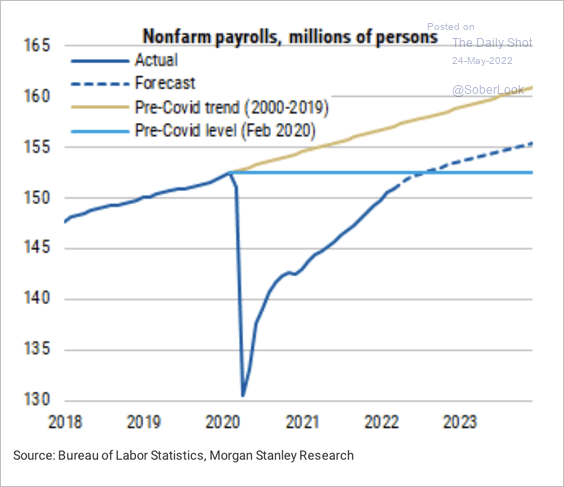 Source: Morgan Stanley Research
Source: Morgan Stanley Research
• Layoffs have been very low in recent months.
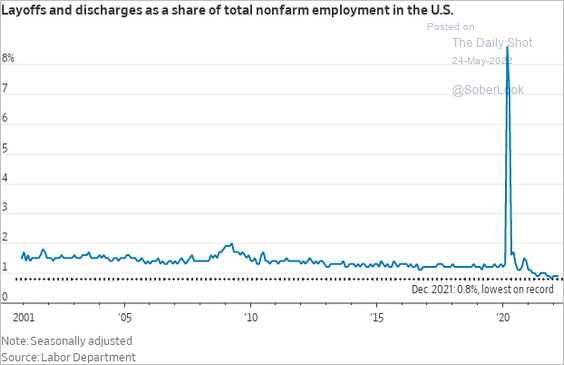 Source: @WSJ Read full article
Source: @WSJ Read full article
But startups are laying off employees to reduce their cash burn as the VC funding market tightens.
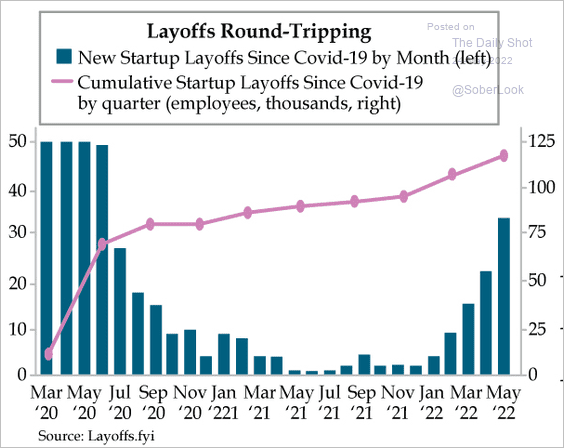 Source: Quill Intelligence
Source: Quill Intelligence
 Source: TechCrunch Read full article
Source: TechCrunch Read full article
• What are the reasons for not working for prime-age adults?
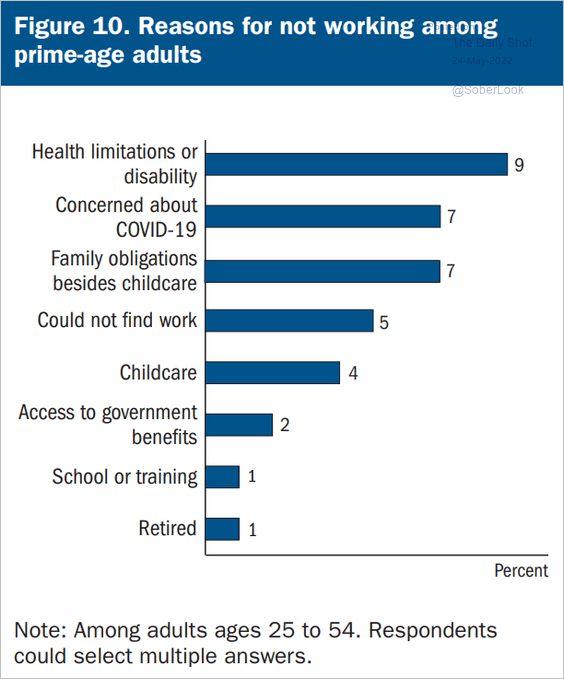 Source: Federal Reserve Board
Source: Federal Reserve Board
• Wage growth hit the highest level in nearly 40 years, according to the Atlanta Fed’s wage tracker.
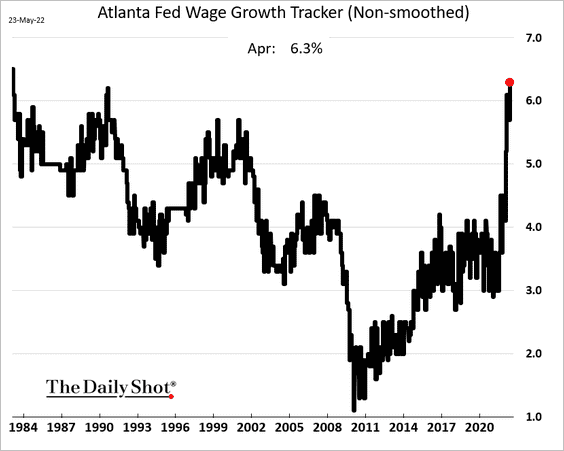
– 70% of companies were boosting wages last quarter.
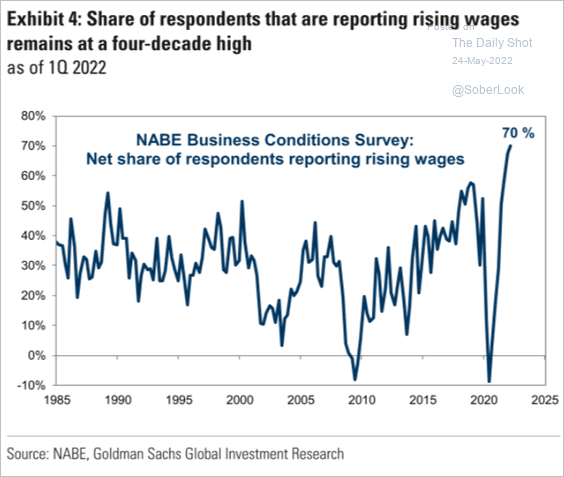 Source: Goldman Sachs
Source: Goldman Sachs
– Prime-age workers have seen particularly strong wage gains.
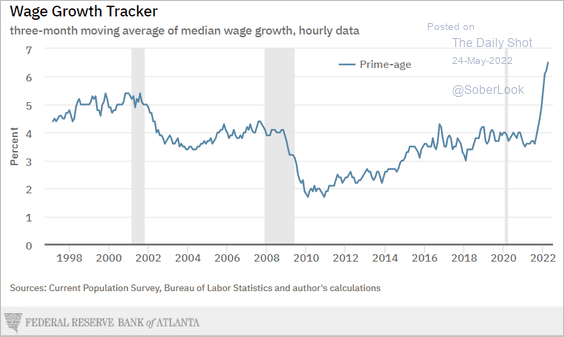 Source: @AtlantaFed
Source: @AtlantaFed
– But is wage growth starting to slow?
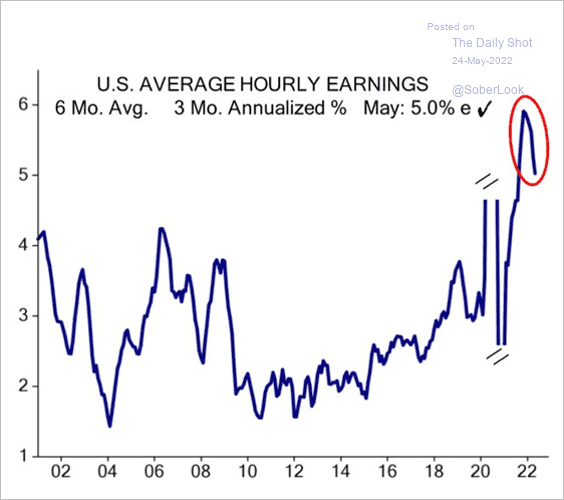 Source: Evercore ISI Research
Source: Evercore ISI Research
• Job hopping has been lucrative.
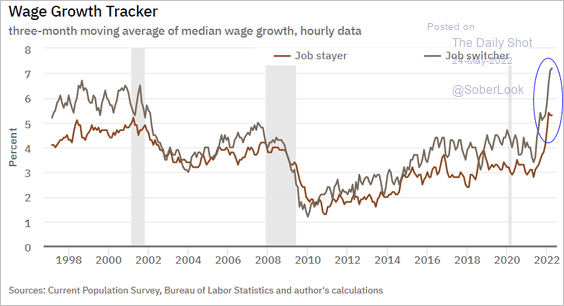 Source: @AtlantaFed
Source: @AtlantaFed
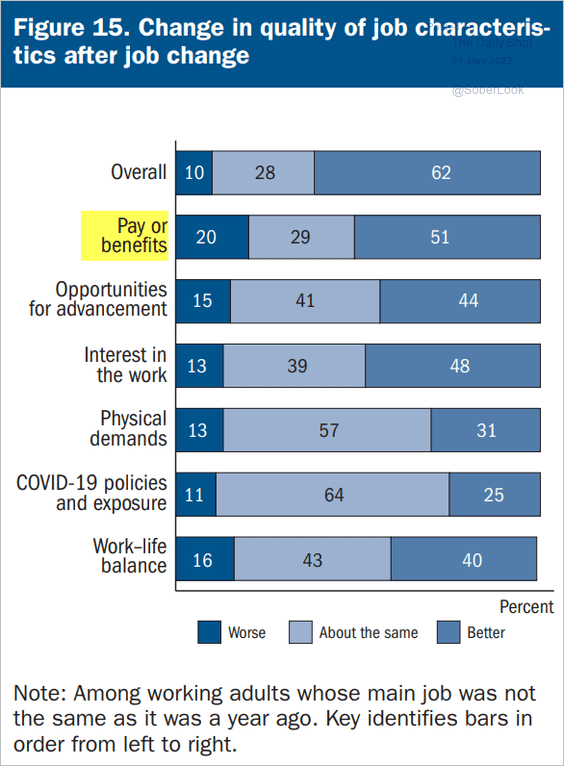 Source: Federal Reserve Board, h/t @SamRo
Source: Federal Reserve Board, h/t @SamRo
• This chart shows the cumulative labor-market generated income.
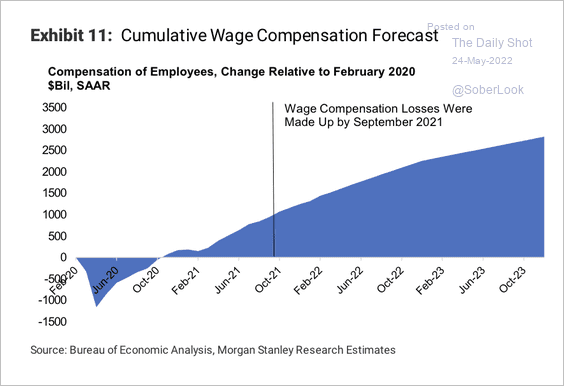 Source: Morgan Stanley Research
Source: Morgan Stanley Research
• Wage gains have been boosting federal tax receipts.
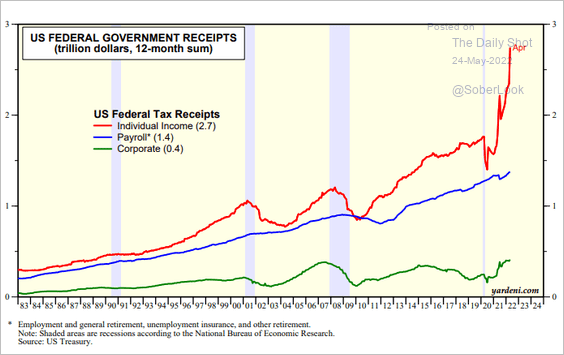 Source: Yardeni Research
Source: Yardeni Research
——————–
2. Next, let’s take a look at supply bottlenecks.
• Shipping capacity is improving.
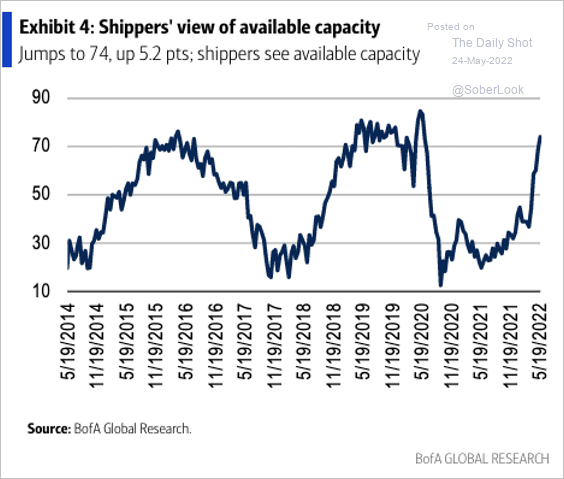 Source: BofA Global Research; @SamRo
Source: BofA Global Research; @SamRo
• The congestion at West Coast ports has been easing.
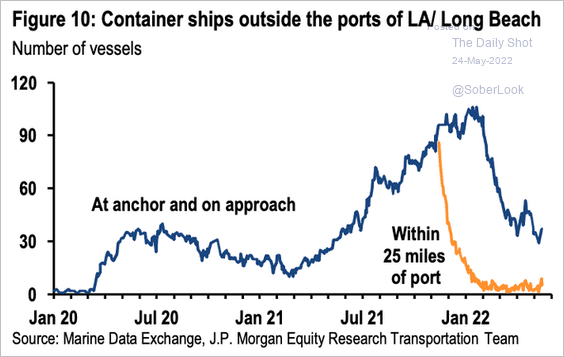 Source: JP Morgan Research; @SamRo
Source: JP Morgan Research; @SamRo
• Shipping rates are expected to moderate.
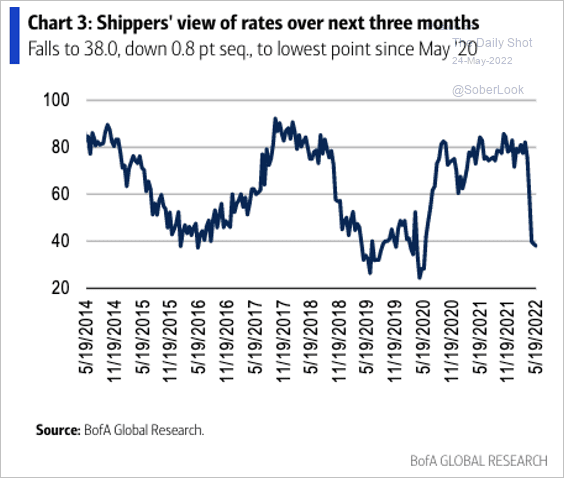 Source: BofA Global Research; @SamRo
Source: BofA Global Research; @SamRo
• But container shipping costs ticked higher last week. Demand is not crashing.
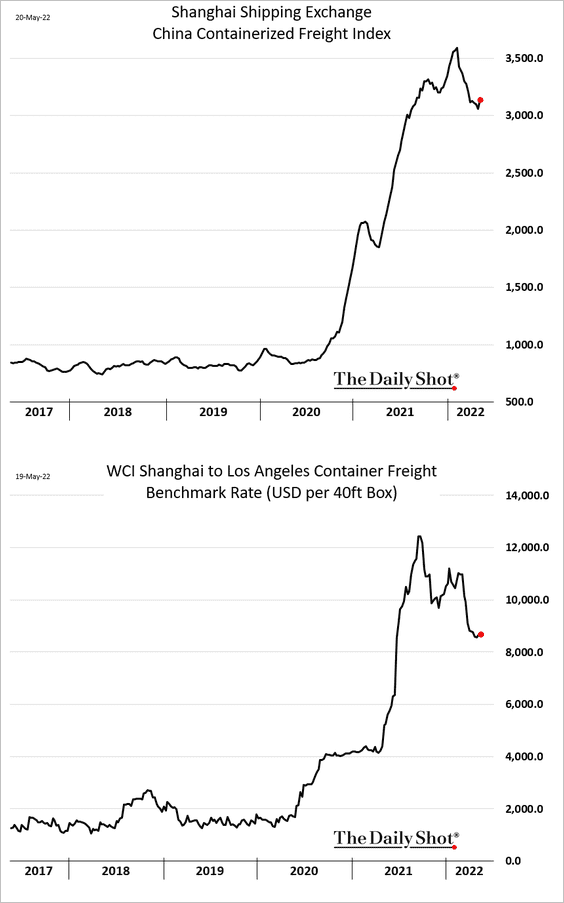
——————–
3. Will the energy share of consumer spending keep climbing?
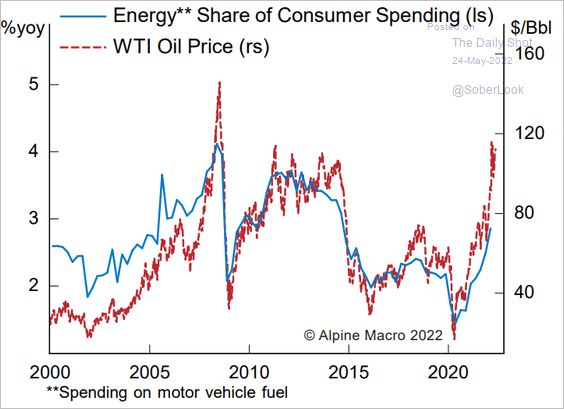 Source: Alpine Macro
Source: Alpine Macro
4. Mobility continues to recover.
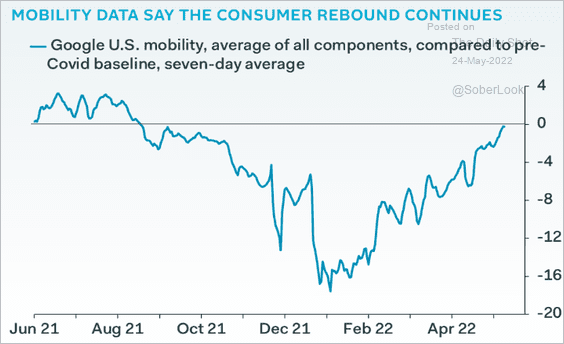 Source: Capital Economics
Source: Capital Economics
Visits to coffee shops have been surging (2nd panel).
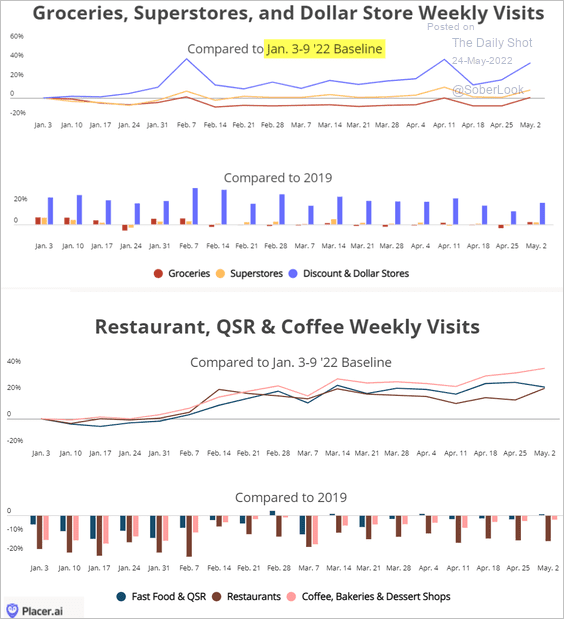 Source: Placer.ai
Source: Placer.ai
——————–
5. Here is the S&P Global Ratings’ recession model.
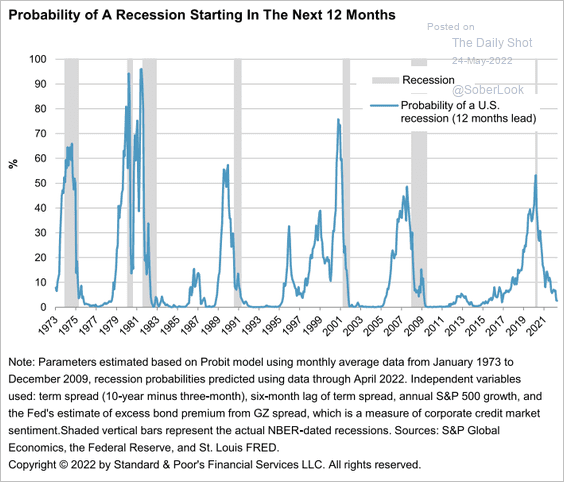 Source: S&P Global Ratings
Source: S&P Global Ratings
Back to Index
The United Kingdom
1. Inflation will remain elevated for some time, according to Pantheon Macroeconomics.
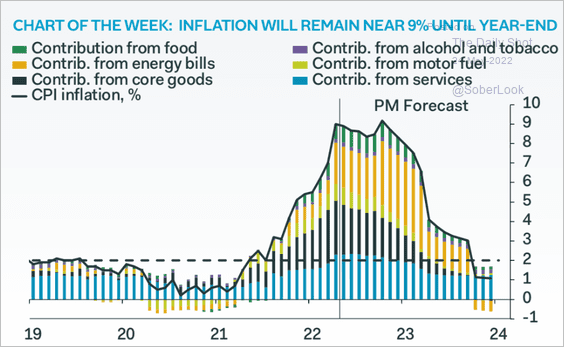 Source: Pantheon Macroeconomics
Source: Pantheon Macroeconomics
Low-income households have experienced the highest inflation.
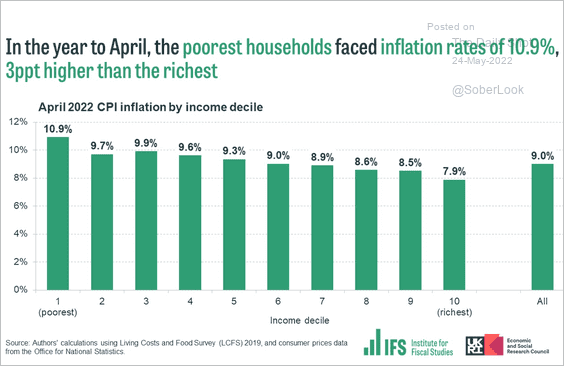 Source: @TheIFS
Source: @TheIFS
——————–
2. The number of EU nationals working in the UK declined during COVID.
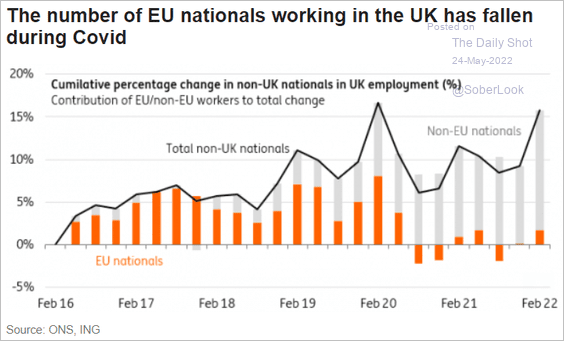 Source: ING
Source: ING
3. Hospital waiting times keep rising.
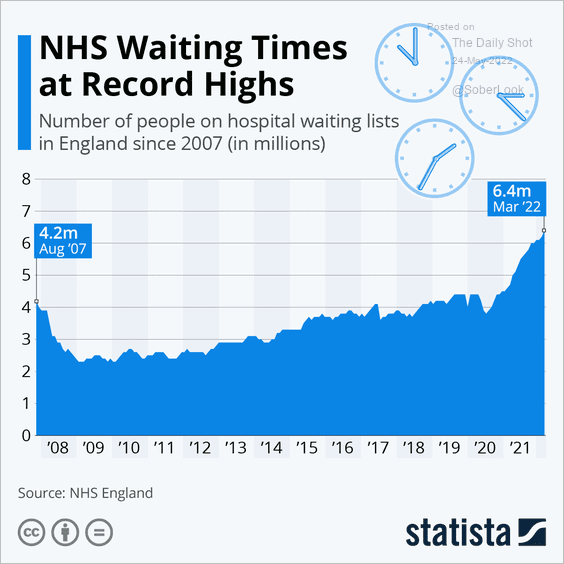 Source: Statista
Source: Statista
Back to Index
The Eurozone
1. Germany’s business sentiment improved this month, although the expectations index was roughly flat.
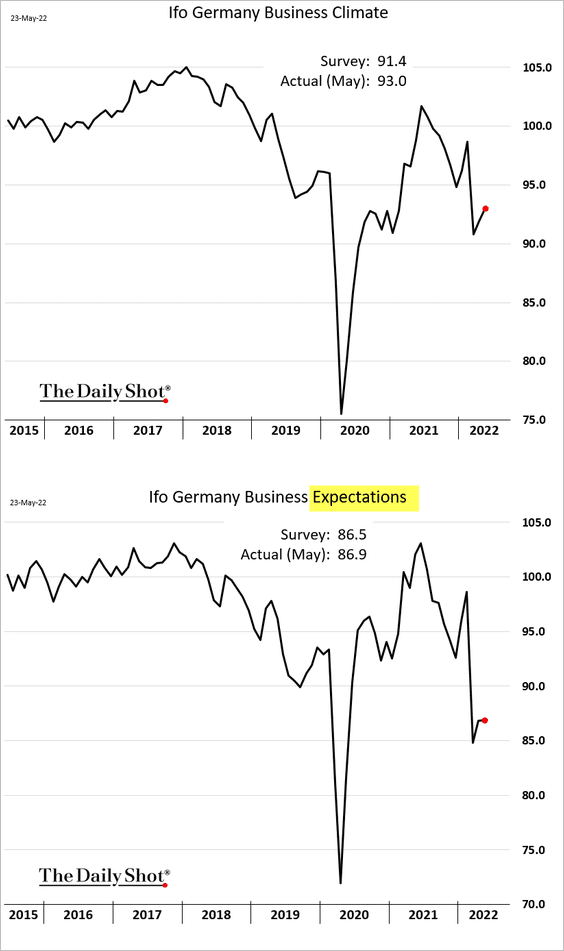
 Source: Reuters Read full article
Source: Reuters Read full article
Service-sector current conditions and expectations indices diverged in May.
 Source: ifo Institute
Source: ifo Institute
Here are a couple of additional updates on Germany.
• Auto manufacturing shifting toward EVs:
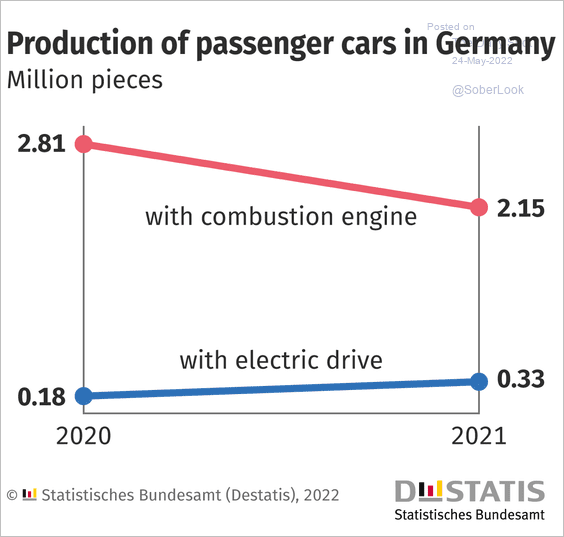 Source: @destatis_news Read full article
Source: @destatis_news Read full article
• German fiscal outlook:
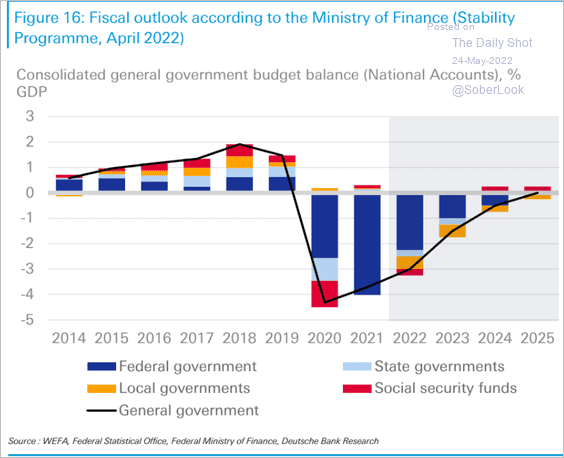 Source: Deutsche Bank Research
Source: Deutsche Bank Research
——————–
2. China’s PPI points to slower producer price gains in the Eurozone going forward.
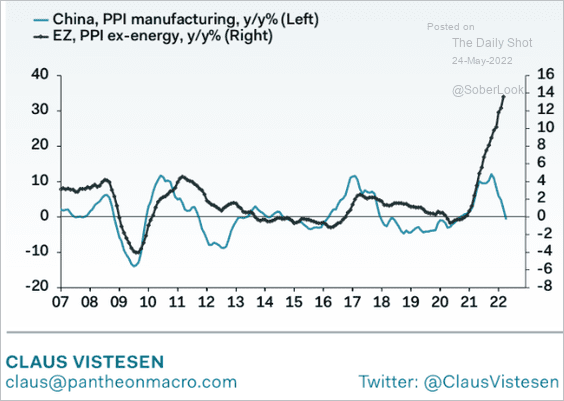 Source: Pantheon Macroeconomics
Source: Pantheon Macroeconomics
3. The euro rebounded from the lows but will face resistance at the 50-day moving average.
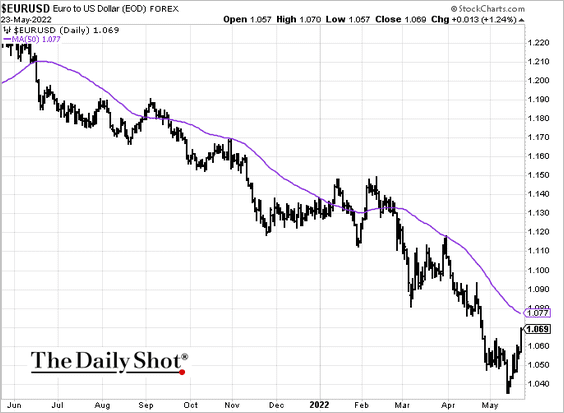
Back to Index
Europe
1. Let’s begin with Poland.
• Core inflation:
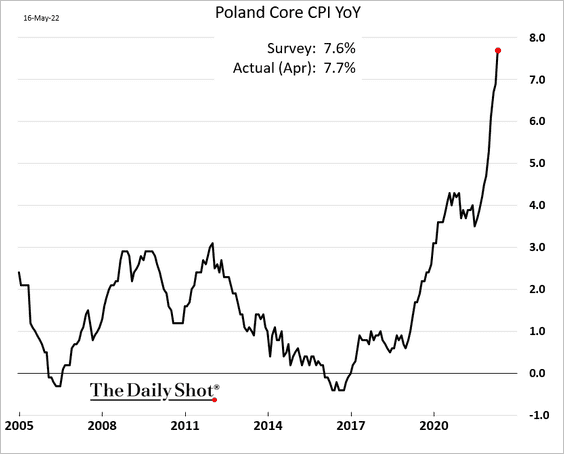
• Retail sales (very strong):
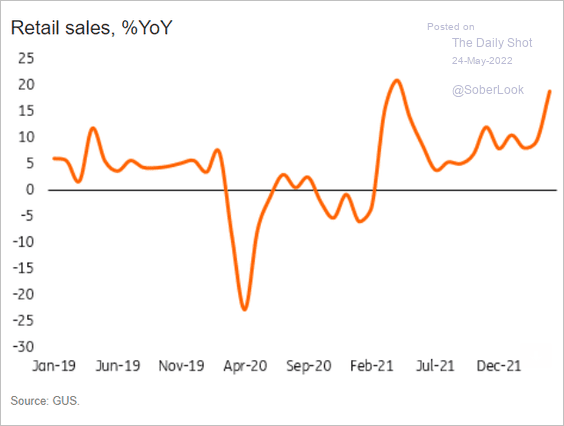 Source: ING
Source: ING
• Construction activity:
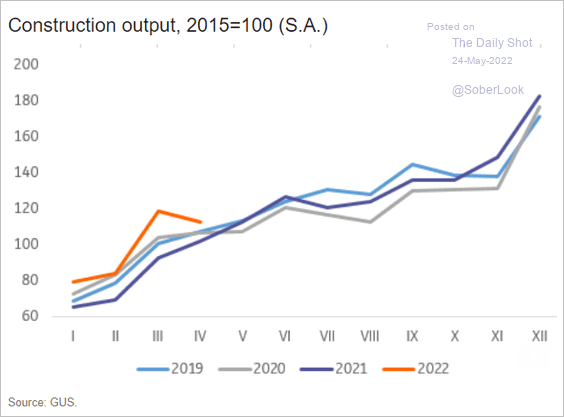 Source: ING
Source: ING
——————–
2. European CapEx has been lagging the US.
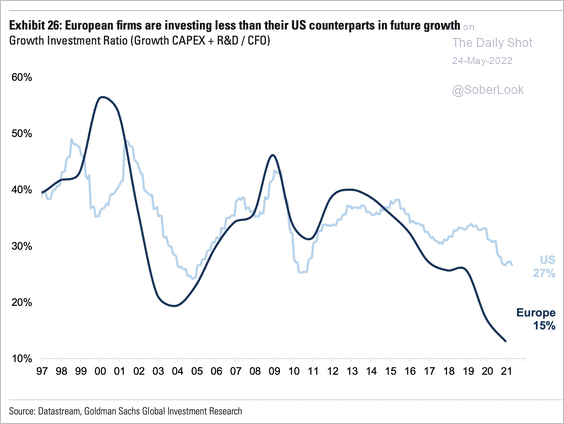 Source: @acemaxx, @GoldmanSachs
Source: @acemaxx, @GoldmanSachs
3. The surge in energy prices has been particularly painful for lower-income households.
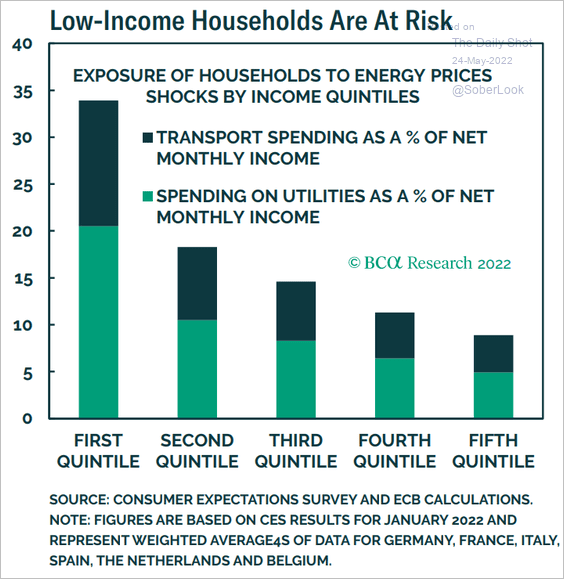 Source: BCA Research
Source: BCA Research
4. Many Europeans lack digital skills (ICT = information and communications technology).
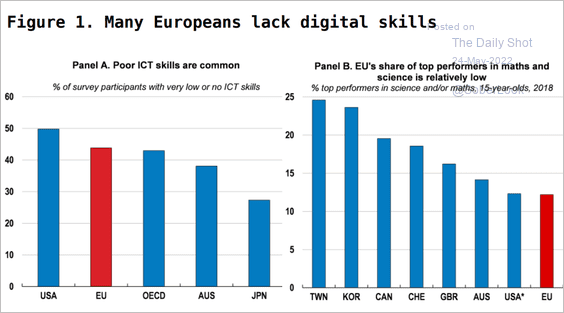 Source: ECOSCOPE Read full article
Source: ECOSCOPE Read full article
Back to Index
Asia – Pacific
1. Japan’s business activity once again showed modest growth this month as service sectors improve.
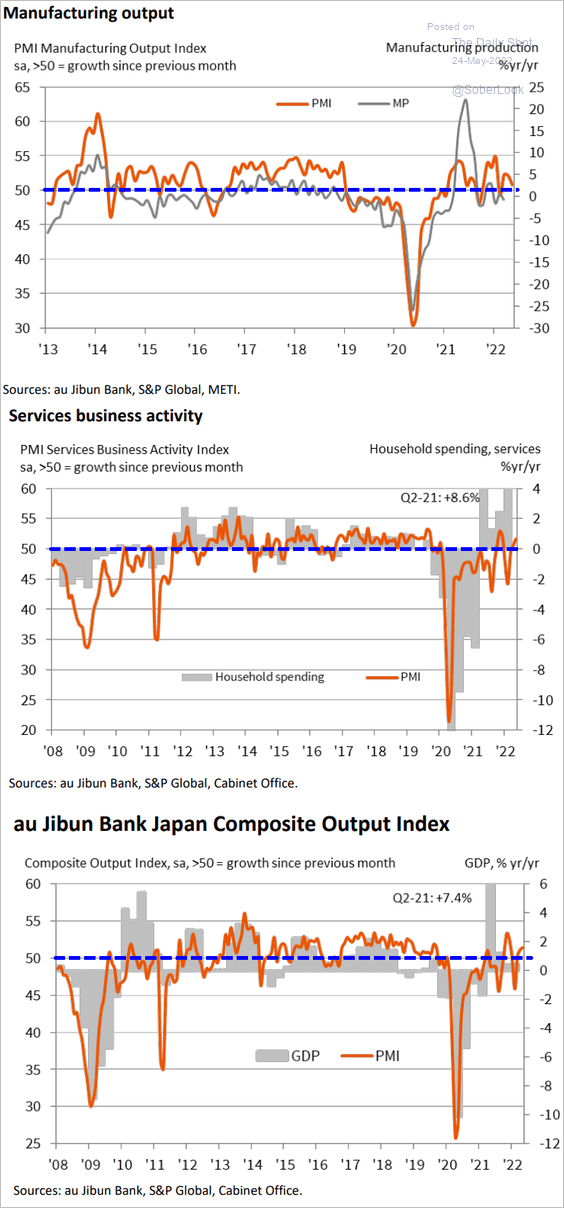 Source: IHS Markit
Source: IHS Markit
2. Growth in Australian business activity slowed but held in positive territory.
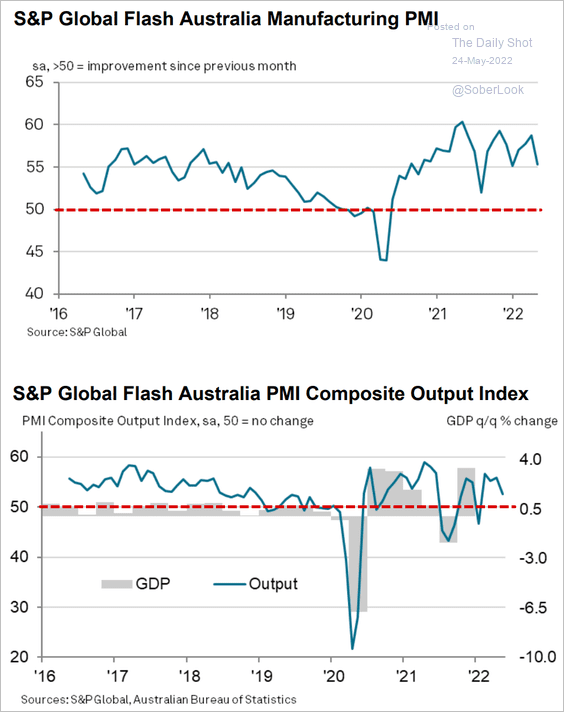 Source: IHS Markit
Source: IHS Markit
3. South Korean consumer confidence has been moderating but remains elevated.
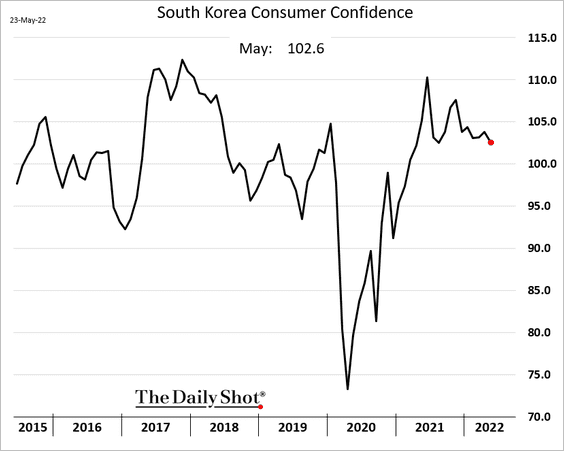
4. Singapore’s CPI continues to rise.
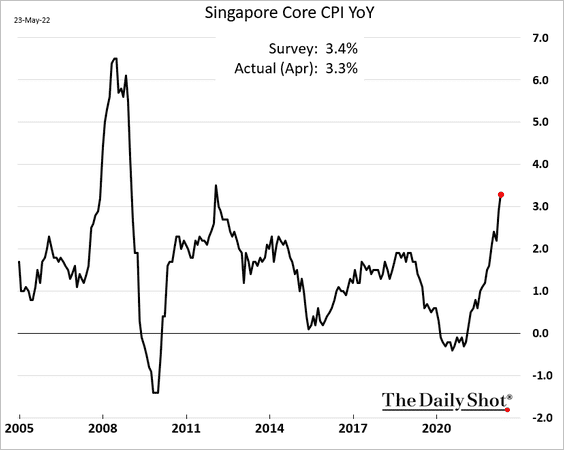
5. Taiwan’s unemployment rate remains very low for this time of the year.
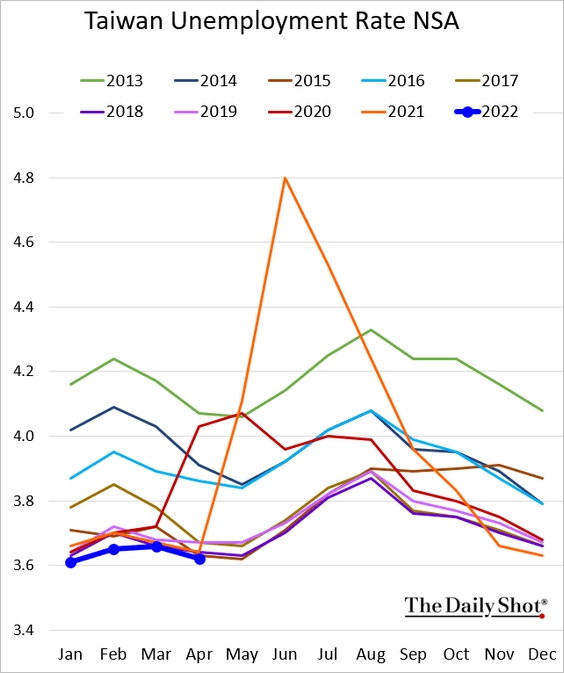
Back to Index
China
1. Hong-Kong listed tech giants continue to struggle.
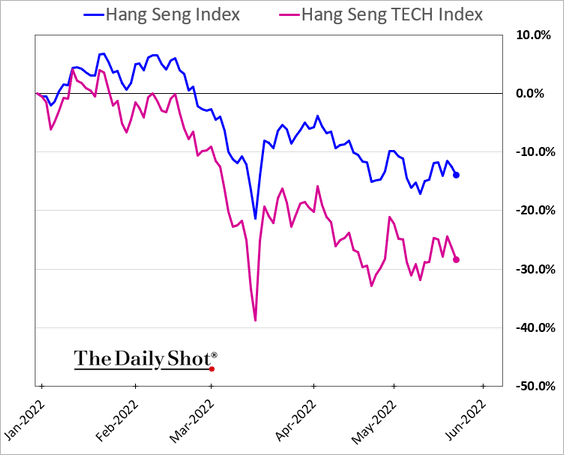
2. The spread between PPI and CPI suggests that manufacturers have been unable to pass on rising input costs to consumers (putting pressure on margins).
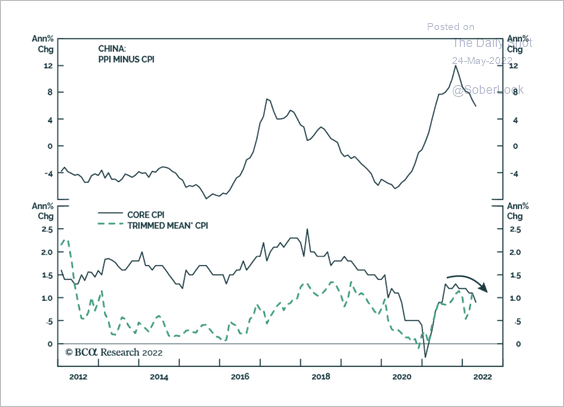 Source: BCA Research
Source: BCA Research
3. This chart shows China’s imports and exports by product.
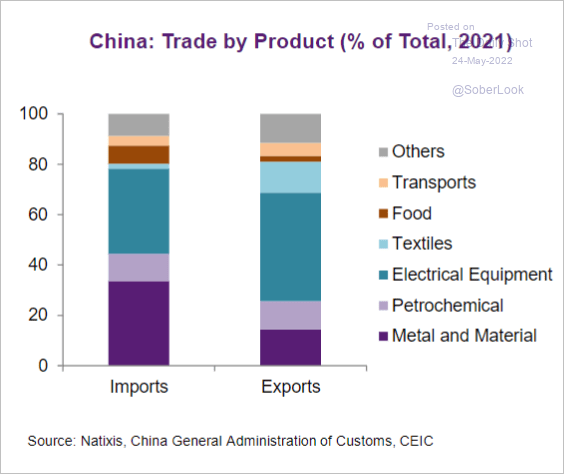 Source: Natixis
Source: Natixis
4. Pork deflation and other factors helped keep China’s food prices from following the global inflation surge.
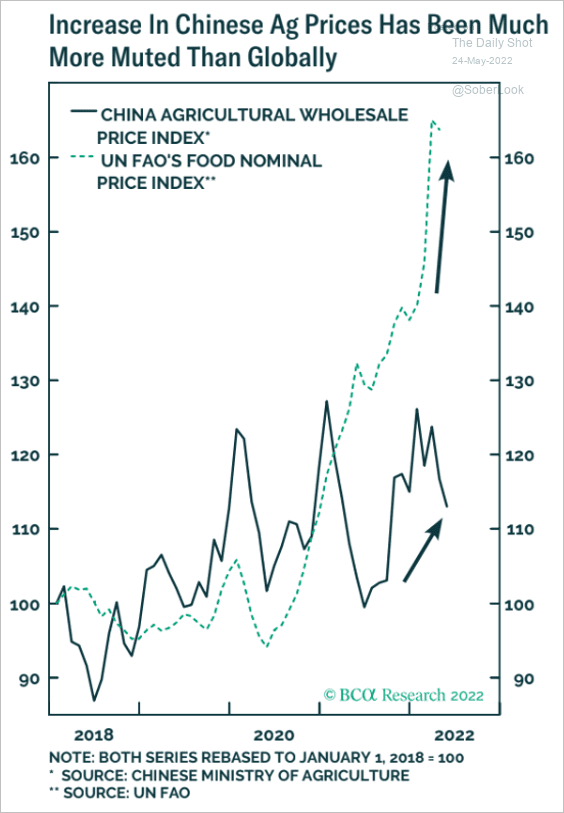 Source: BCA Research
Source: BCA Research
Hong Kong’s inflation remains modest.
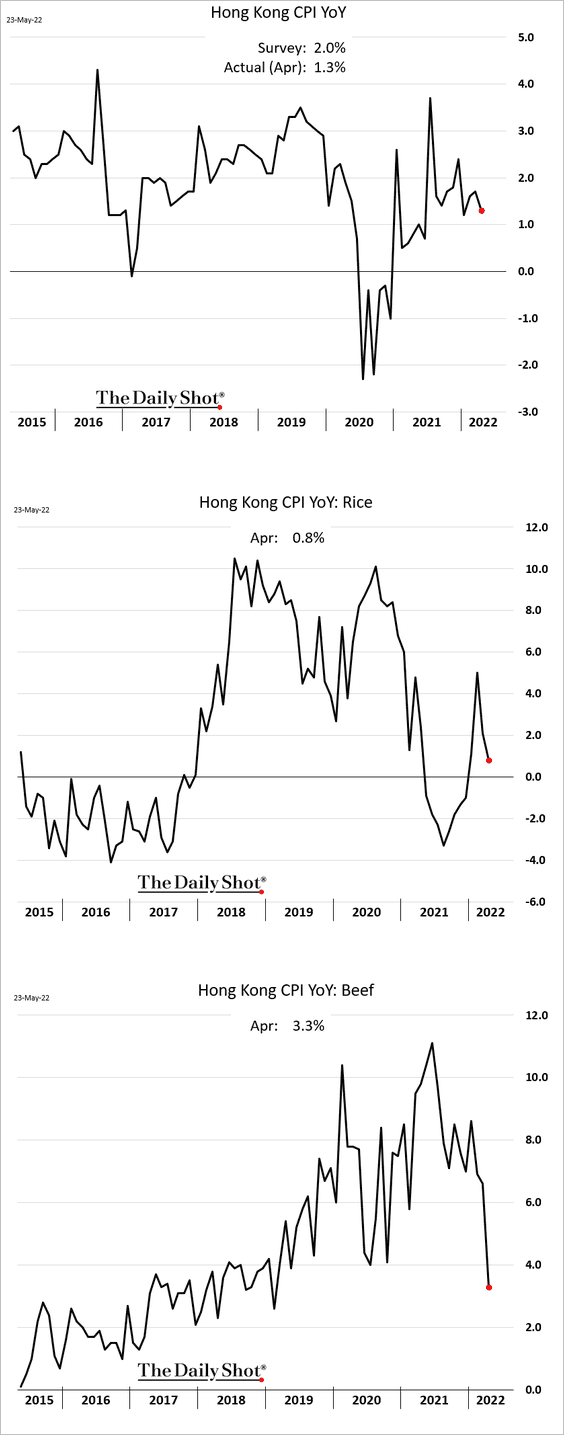
——————–
5. Youth unemployment has been rising.
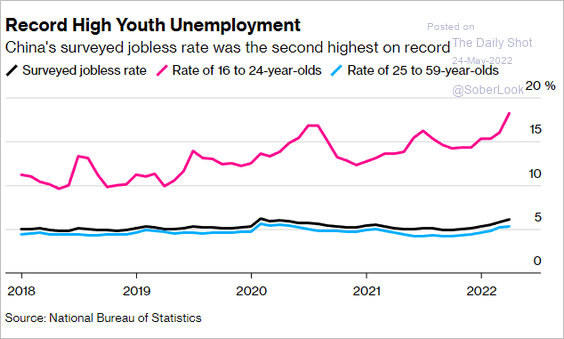 Source: Bloomberg Read full article
Source: Bloomberg Read full article
6. Here is the breakdownd of China’s GDP by sector.
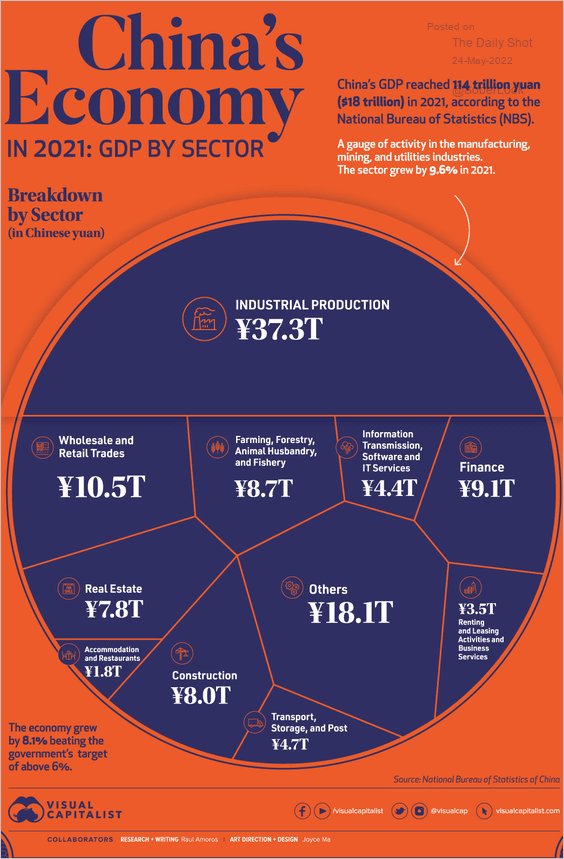 Source: Visual Capitalist Read full article
Source: Visual Capitalist Read full article
Back to Index
Emerging Markets
1. Turkish manufacturing confidence has been declining but not collapsing.
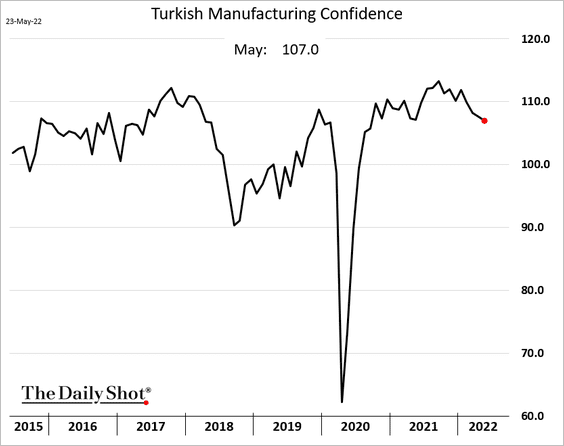
2. EM local-currency debt (EMLCD) spreads started the year at above-average levels, reflecting the early tightening by many EM central banks. Spreads have declined sharply since then, albeit still higher than their long-term average.
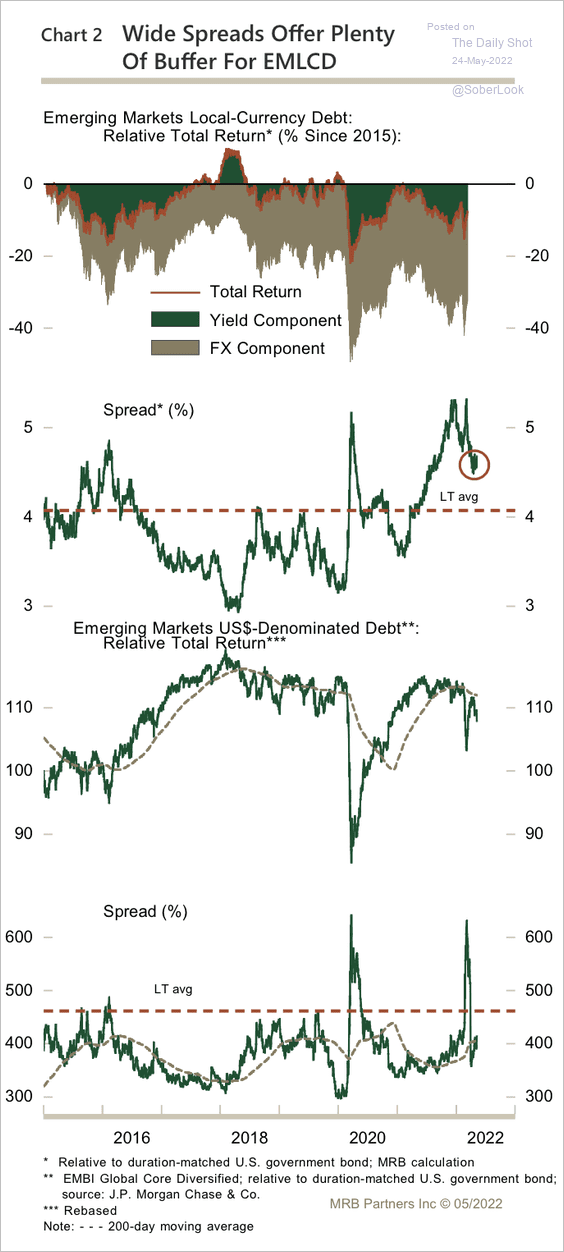 Source: BCA Research
Source: BCA Research
3. EM currencies have been more resilient against USD than DM currencies.
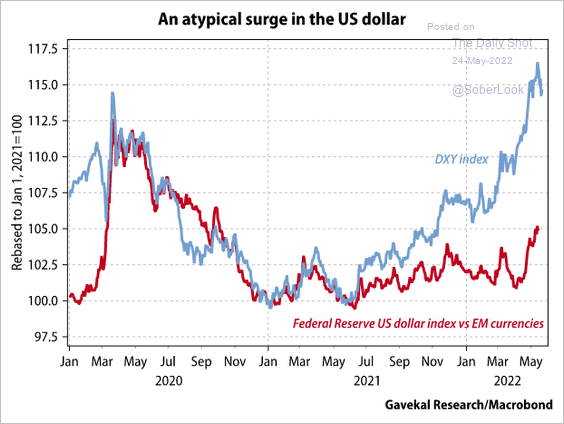 Source: Gavekal Research
Source: Gavekal Research
But low real policy rates make some countries’ currencies vulnerable.
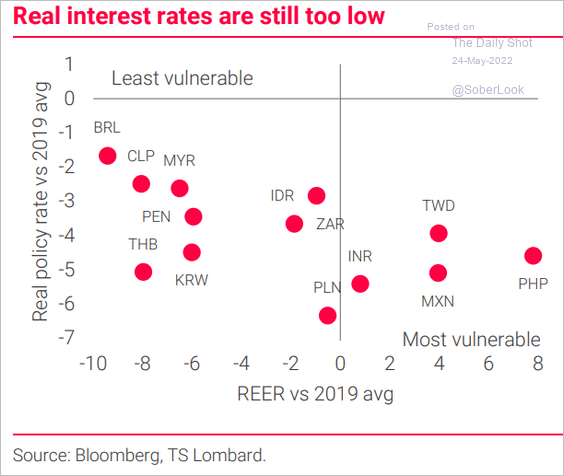 Source: TS Lombard
Source: TS Lombard
——————–
4. The MSCI equity index weights have been shifting toward Asia.
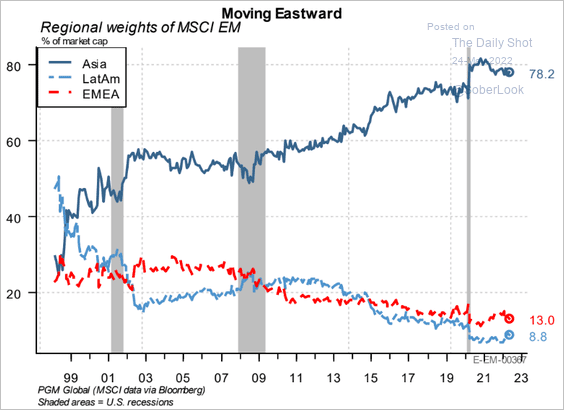 Source: PGM Global
Source: PGM Global
5. Here are the drivers of inflation in select economies.
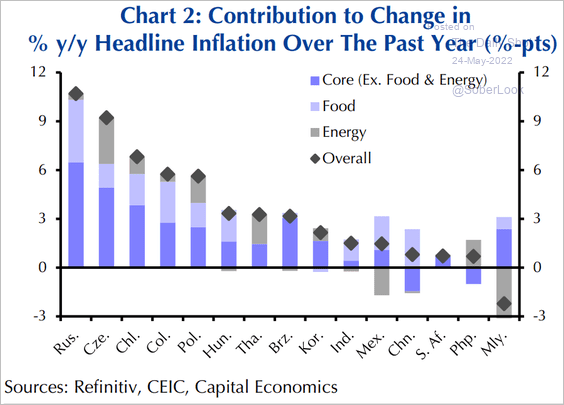 Source: Capital Economics
Source: Capital Economics
Back to Index
Cryptocurrency
1. Bitcoin is trading near support (just below $30k).
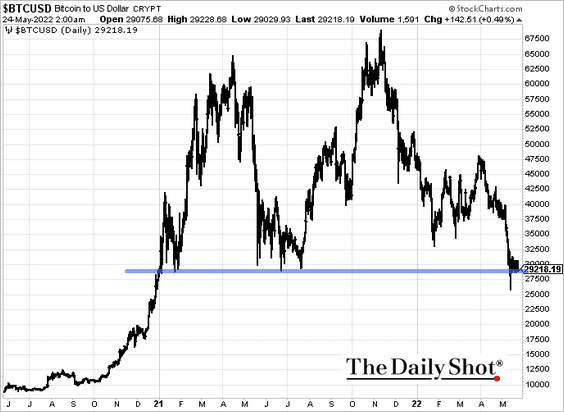
2. Crypto investment products saw outflows totaling $141 million last week.
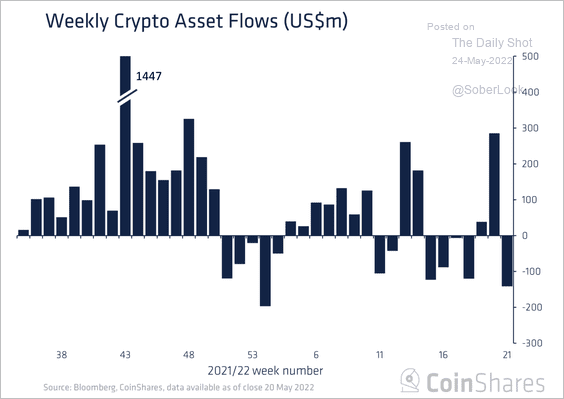 Source: CoinShares Read full article
Source: CoinShares Read full article
Bitcoin and Ethereum-focused products saw the most outflows last week, while multi-asset funds attracted inflows.
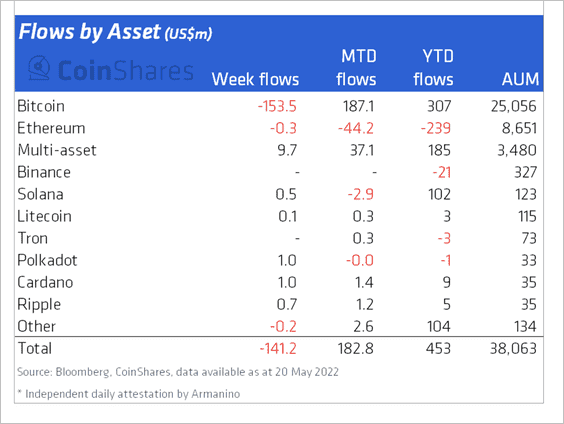 Source: CoinShares Read full article
Source: CoinShares Read full article
——————–
3. This chart shows prior peaks and troughs in bitcoin and the dollar.
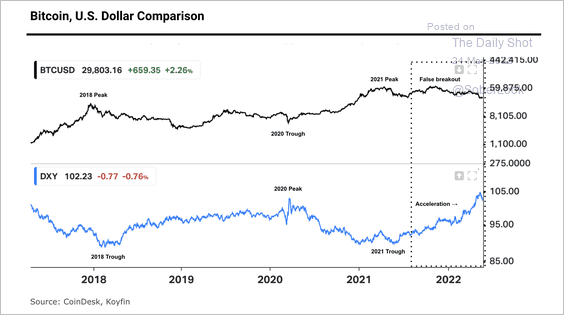 Source: CoinDesk Read full article
Source: CoinDesk Read full article
4. Bitcoin’s correlation with the dollar is mostly negative, but has risen during times of market turbulence such as 2018 and 2020.
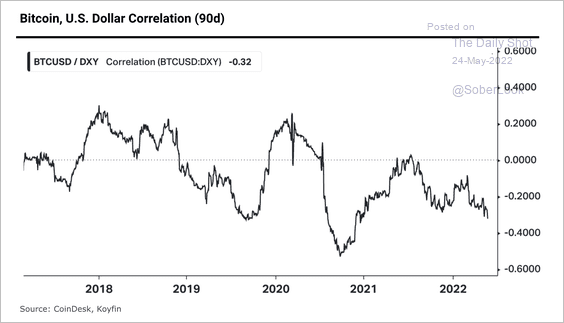 Source: CoinDesk Read full article
Source: CoinDesk Read full article
5. The algorithmic stablecoin market didn’t last very long.
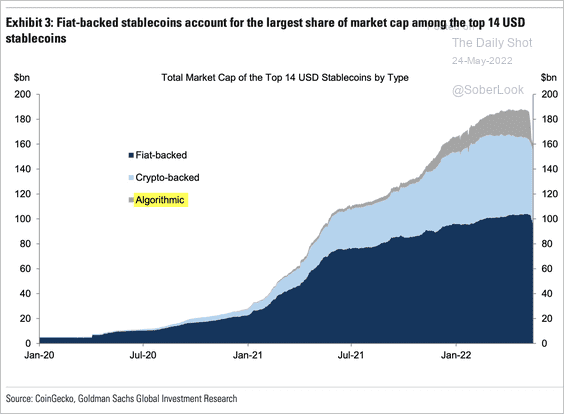 Source: Goldman Sachs
Source: Goldman Sachs
Back to Index
Commodities
1. Fitch expects aluminum prices to decline this quarter because of the economic slowdown in China. Although prices could stabilize in the second half of the year.
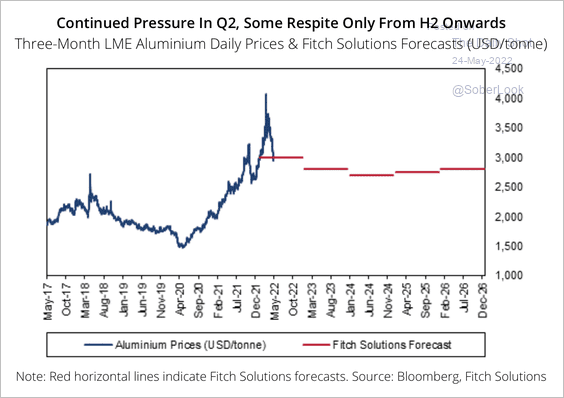 Source: Fitch Solutions Macro Research
Source: Fitch Solutions Macro Research
Over time, prices could remain elevated as manufacturers increase aluminum intensity in light-weight electric vehicles, according to Fitch.
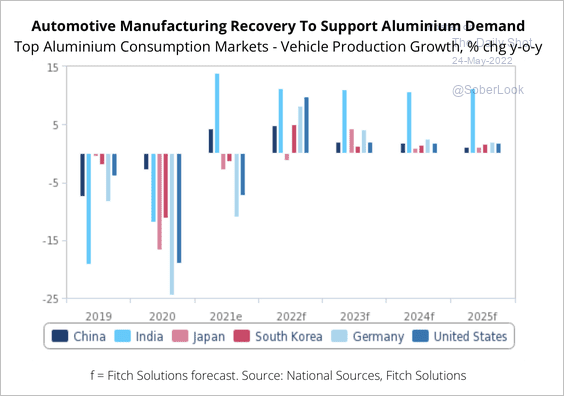 Source: Fitch Solutions Macro Research
Source: Fitch Solutions Macro Research
——————–
2. Copper exports from Chile and Peru have fallen below trend.
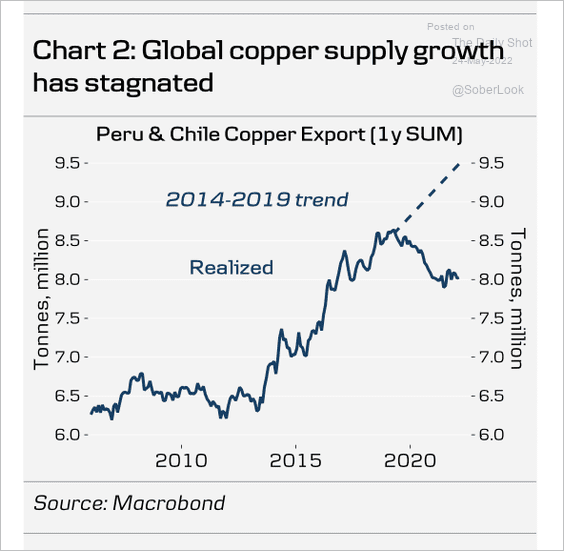 Source: Danske Bank
Source: Danske Bank
3. Several large miners reported a reduction in metal supply last quarter.
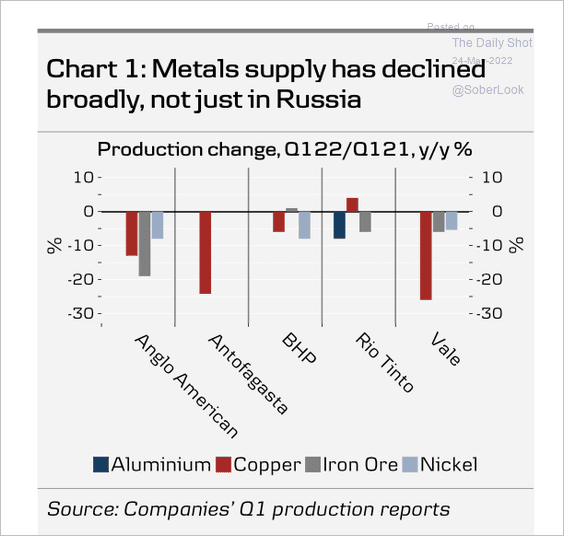 Source: Danske Bank
Source: Danske Bank
Mining firms have significantly reduced capital spending over the past decade.
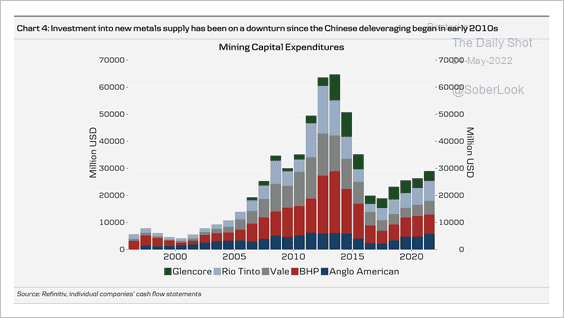 Source: Danske Bank
Source: Danske Bank
——————–
4. Both coffee and cotton futures curves are in deep backwardation, providing an opportunity for traders to buy longer-dated contracts and pick up the roll yield.
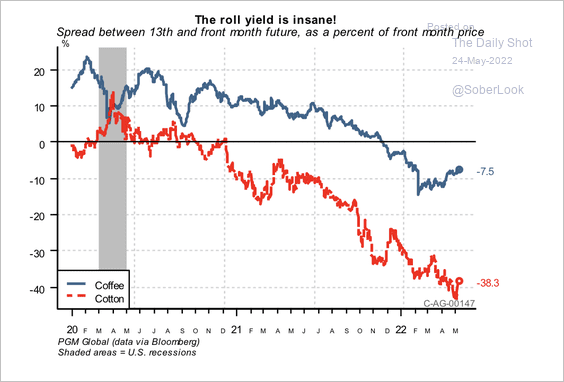 Source: PGM Global
Source: PGM Global
5. Global wheat exports are expected to grow over the next year.
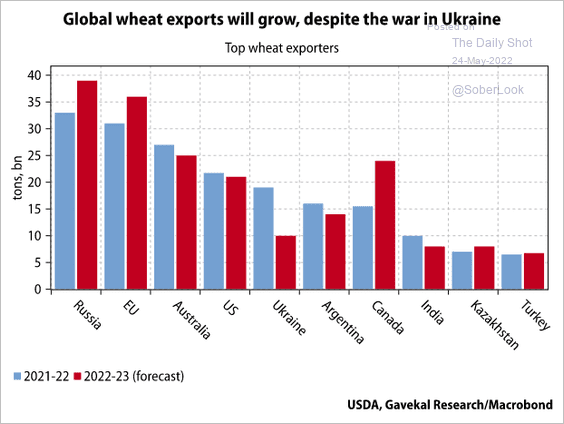 Source: Gavekal Research
Source: Gavekal Research
6. Severe heat and drought conditions could lower US agriculture supplies. That could keep food prices elevated this season.
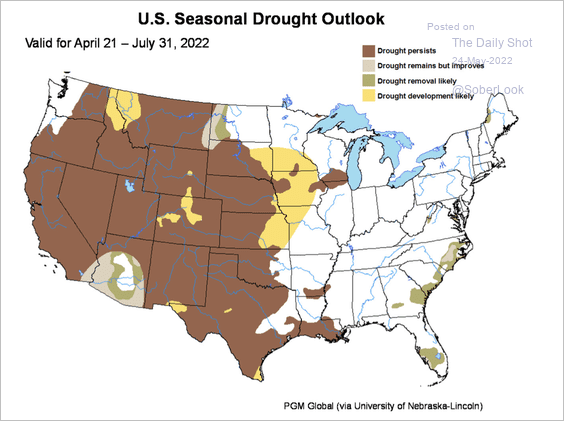 Source: PGM Global
Source: PGM Global
7. US corn and soy planting progress is rebounding, but wheat remains a problem.
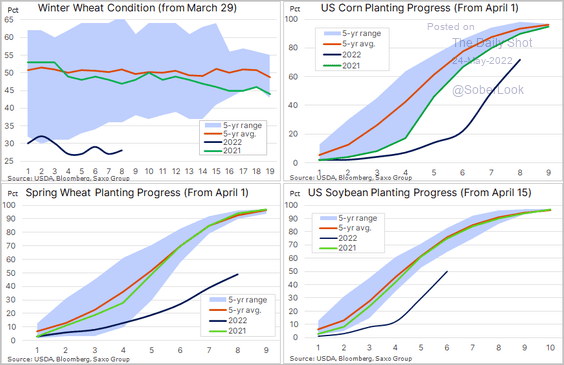 Source: @Ole_S_Hansen
Source: @Ole_S_Hansen
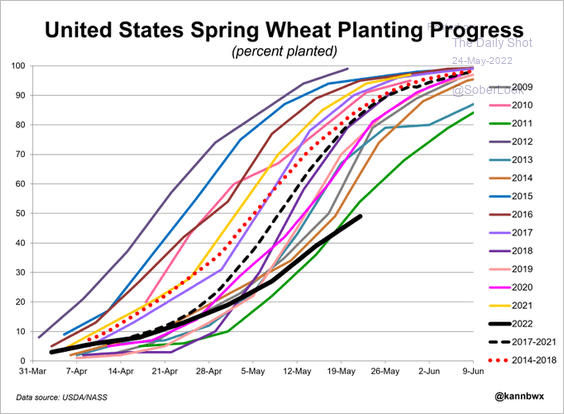 Source: @kannbwx
Source: @kannbwx
Here is North Dakota’s spring (high-protein) wheat planting progress.
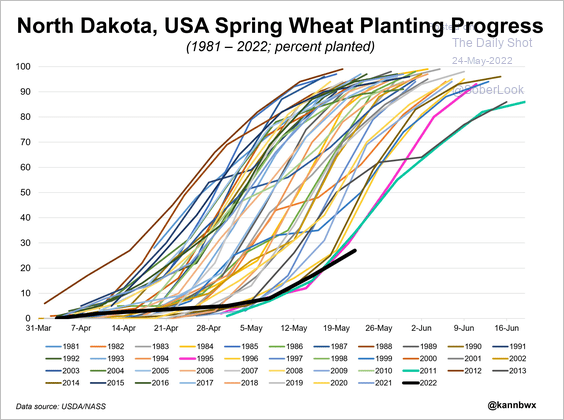 Source: @kannbwx
Source: @kannbwx
Back to Index
Energy
1. Brent has been holding the uptrend support.
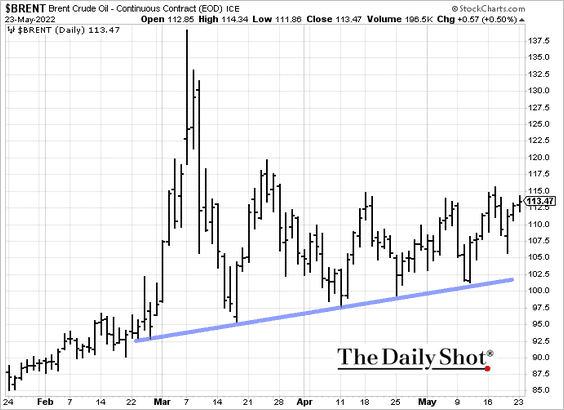
2. European natural gas inventories have been improving.
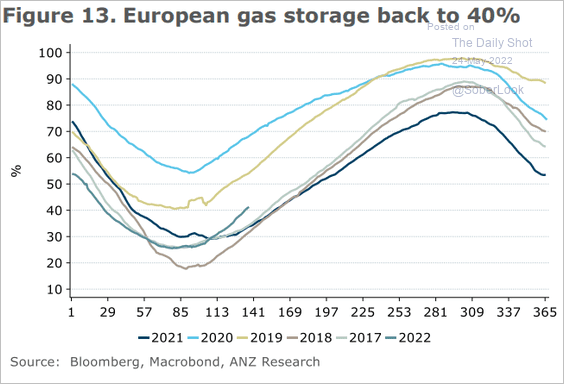 Source: @ANZ_Research
Source: @ANZ_Research
3. This chart shows US summer electricity generation by source.
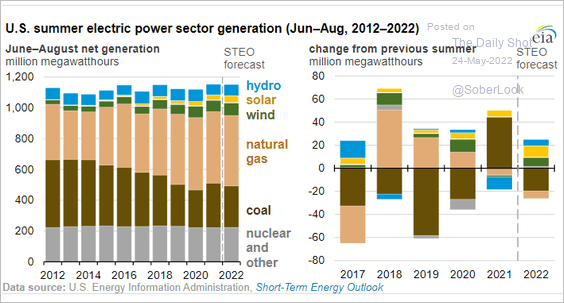 Source: EIA Read full article
Source: EIA Read full article
Back to Index
Equities
1. Stocks jumped on Monday, boosted by banks.
 Source: @financialtimes Read full article
Source: @financialtimes Read full article
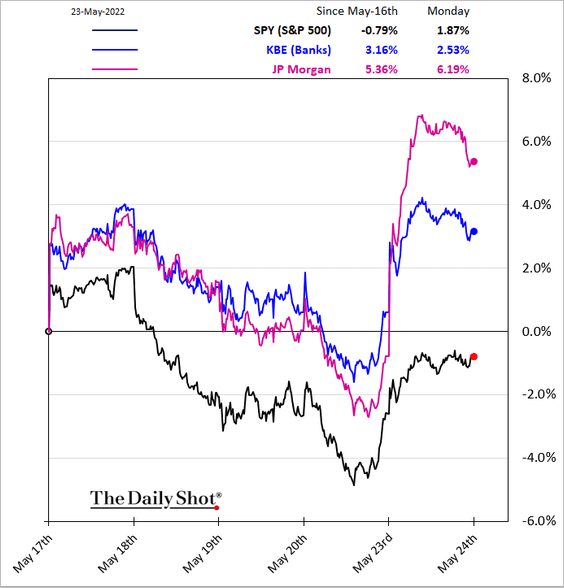
If there is no recession, the banking sector has room to outperform.
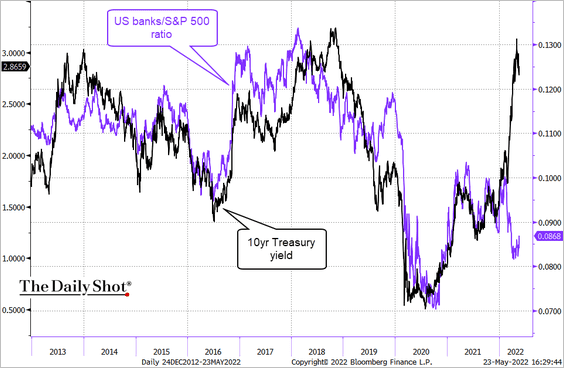 Source: @TheTerminal, Bloomberg Finance L.P.
Source: @TheTerminal, Bloomberg Finance L.P.
——————–
2. The social media sector got some bad news after hours from Snap.
 Source: CNBC Read full article
Source: CNBC Read full article
Social media stocks tumbled …
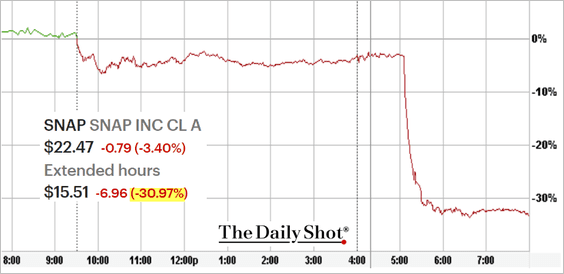
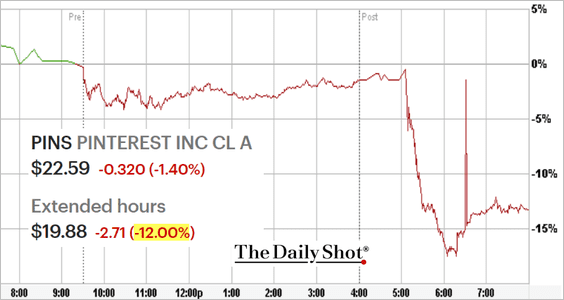
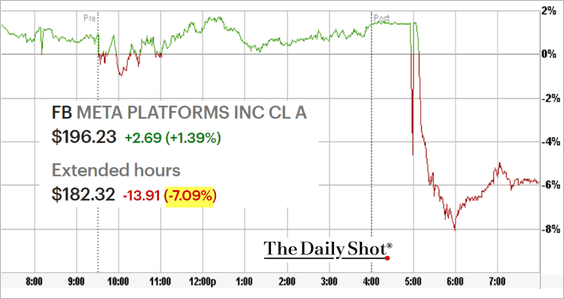
… pulling stock futures sharply lower (giving up Monday’s gains).
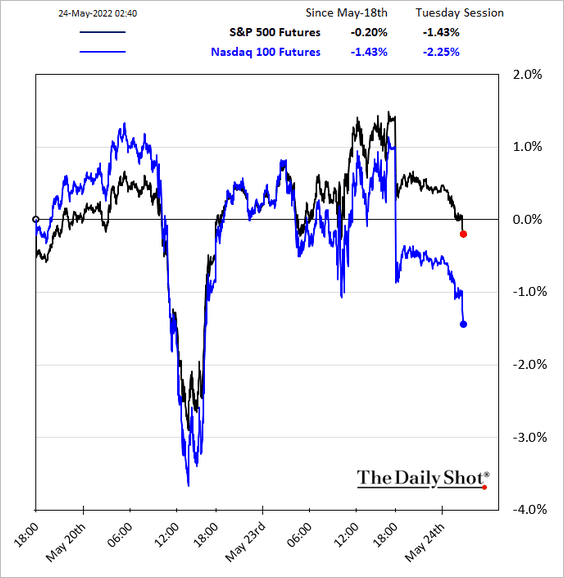
——————–
3. The Nasdaq 100/S&P 500 ratio is at long-term support.
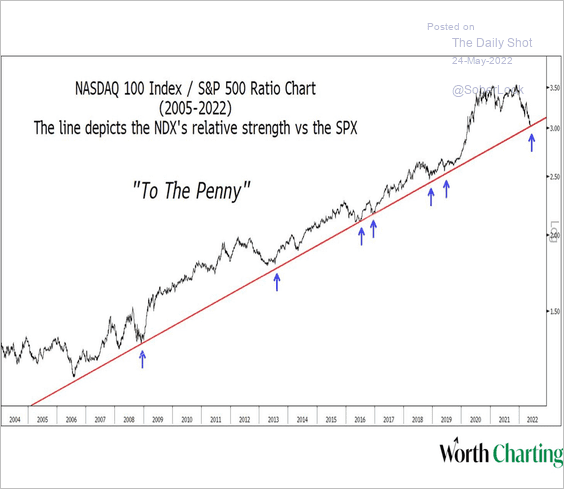 Source: @CarterBWorth
Source: @CarterBWorth
4. This chart shows fund managers’ positioning by sector, based on a survey from BofA.
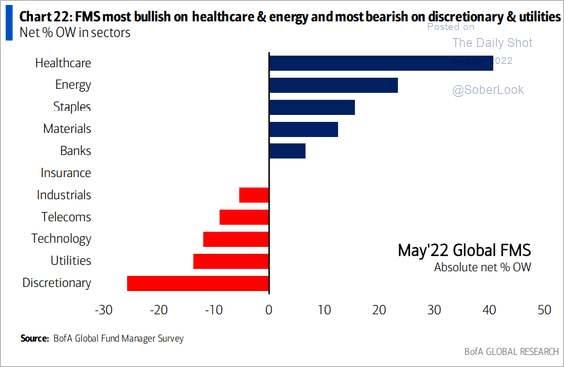 Source: BofA Global Research
Source: BofA Global Research
5. Gold points to further upside in equity risk premium.
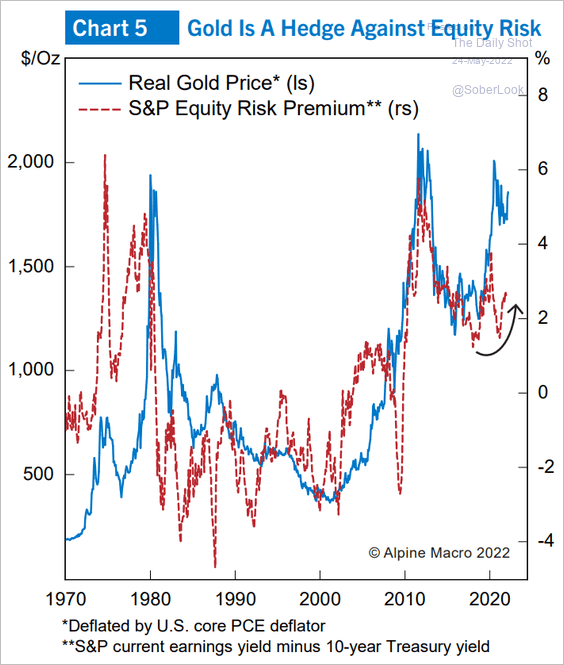 Source: Alpine Macro
Source: Alpine Macro
6. Markets expect a decline in dividends next year.
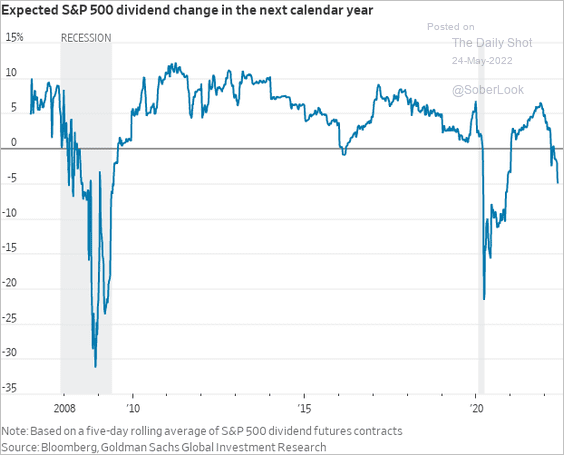 Source: @WSJ
Source: @WSJ
7. How do stocks perform after moving into a bear market?
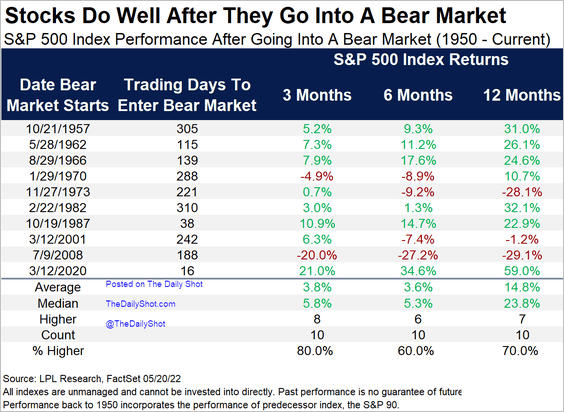 Source: LPL Research
Source: LPL Research
8. How much of a selloff should we expect if the US economy enters a recession?
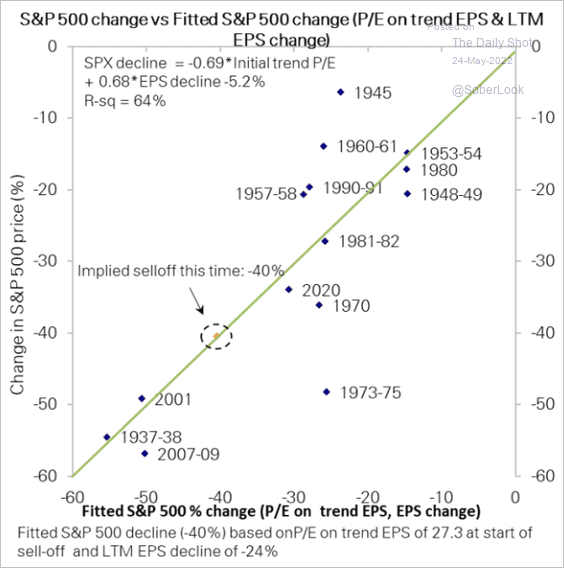 Source: Deutsche Bank Research
Source: Deutsche Bank Research
How do stocks perform around recessions?
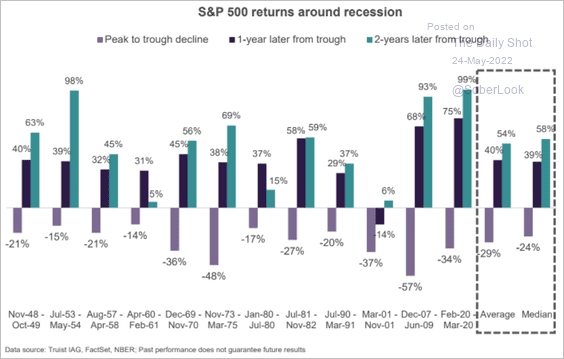 Source: Truist Advisory Services
Source: Truist Advisory Services
——————–
9. Is Walmart signaling further pain for the stock market?
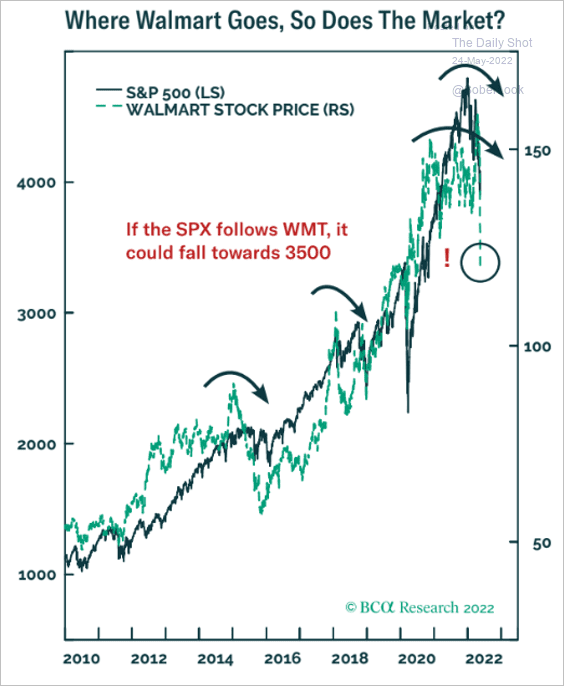 Source: BCA Research
Source: BCA Research
10. The ratio of Russell 1000 to Russell 2000 held resistance. Will small caps outperform from here?
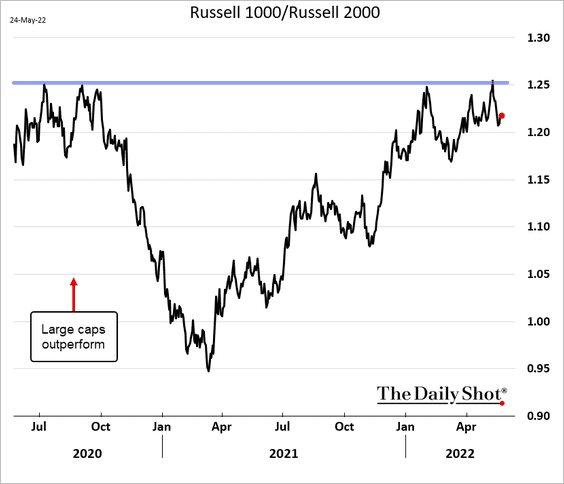
Speculative accounts have been very short Russell 2000 futures.
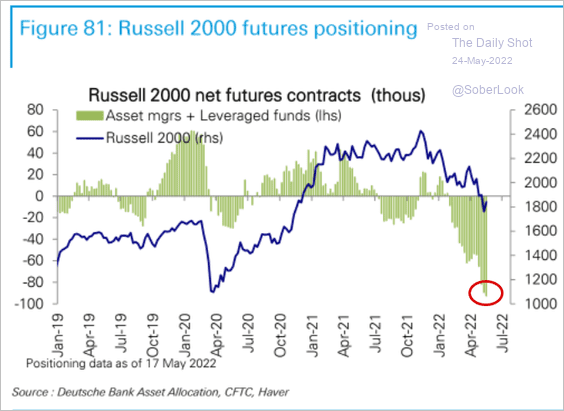 Source: Deutsche Bank Research
Source: Deutsche Bank Research
——————–
11. US material stocks face downside risks as they converge with their Chinese counterparts. Still, valuations are relatively attractive despite being overbought in the short term.
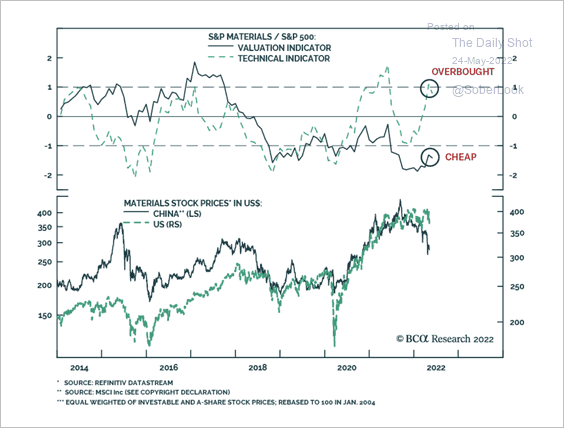 Source: BCA Research
Source: BCA Research
Materials sector ETFs saw outflows over the past four weeks.
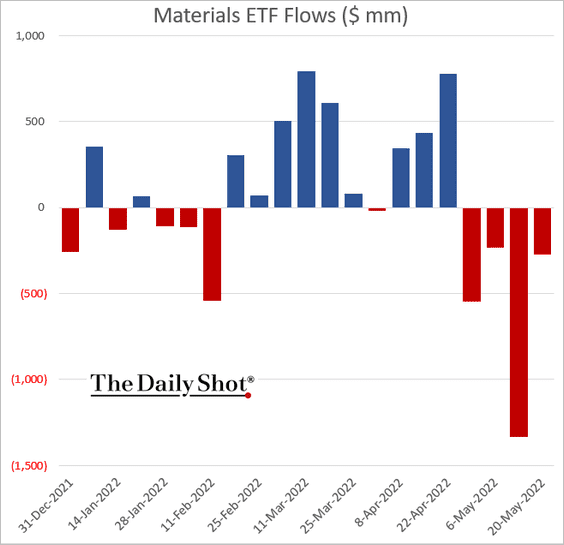
——————–
12. The S&P Risk Parity index has outperformed substantially in recent weeks.
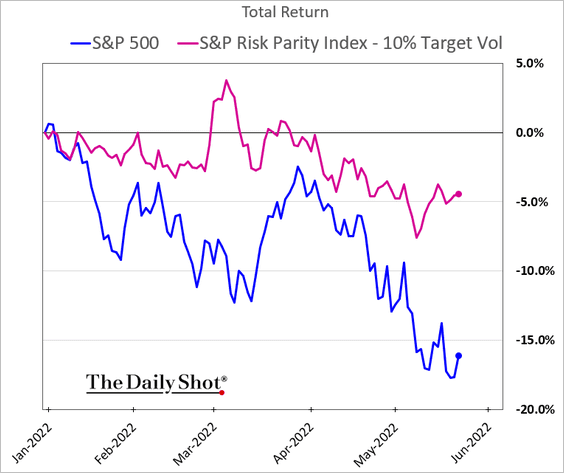
Back to Index
Rates
1. Market pricing for the total rate hike in 2022 has stabilized at around 2.7%.
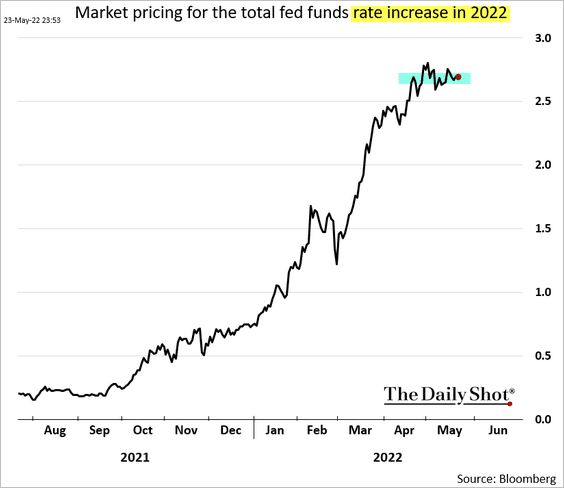
2. Demand for cash instruments has been surging as risk assets slump. The Fed’s RRP balances jumped above $2 trillion.
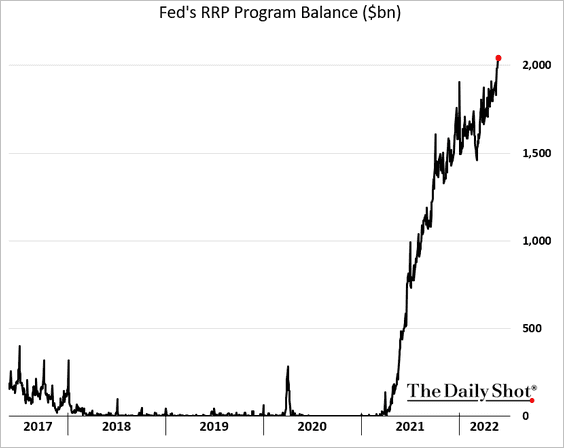
The spread between the TGCR tri-party collateral rate in the Fed’s reverse repo overnight rate has moved into negative territory. Will the Fed raise the counterparty limits to let more money market fund cash into the program?
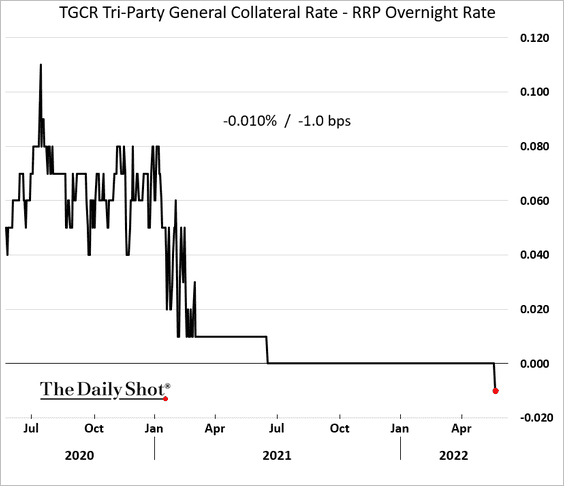
Back to Index
Global Developments
1. Global firms are increasingly talking about “nearshoring,” “onshoring,” and “reshoring.”
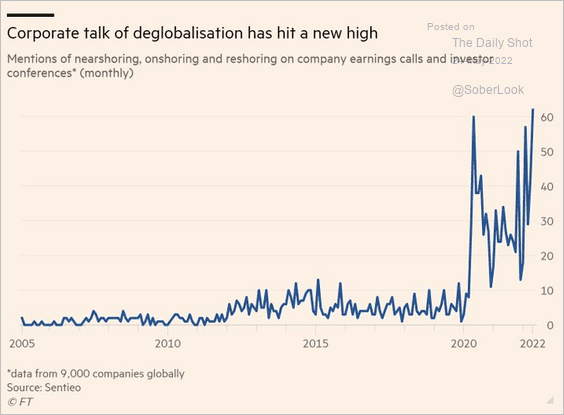 Source: @jessefelder, @financialtimes Read full article
Source: @jessefelder, @financialtimes Read full article
2. Global supply chain stress is no longer driven by demand.
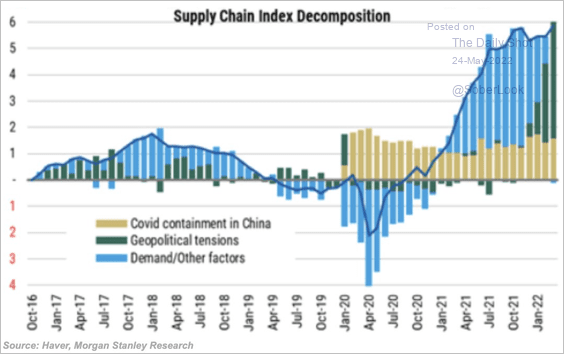 Source: @acemaxx, @MorganStanley
Source: @acemaxx, @MorganStanley
3. In most G-10 economies, a relatively small portion of outstanding debt is linked to inflation rates. Therefore, higher inflation can reduce the real cost of government debt over time.
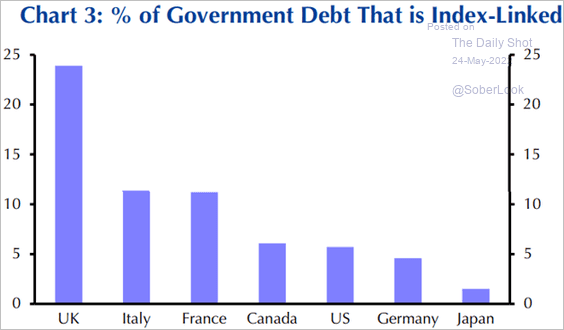 Source: Capital Economics
Source: Capital Economics
4. More OECD countries are experiencing an economic slowdown.
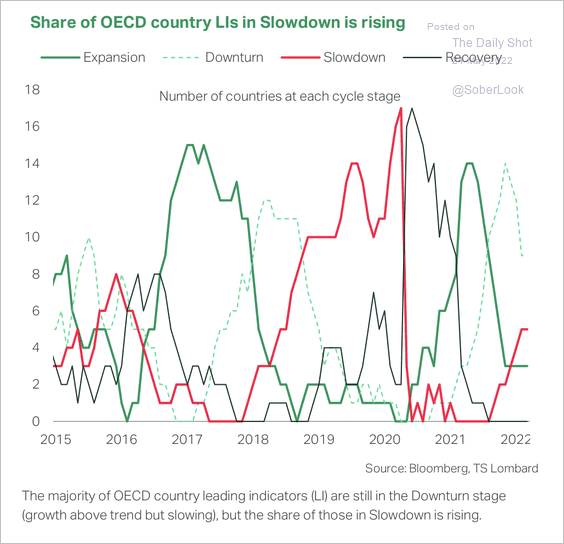 Source: TS Lombard
Source: TS Lombard
——————–
Food for Thought
1. Consumption of financial advice in the US:
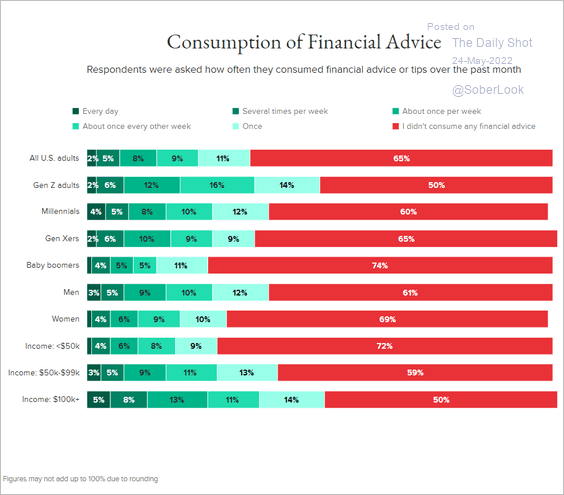 Source: Morning Consult Read full article
Source: Morning Consult Read full article
2. Small firms’ concerns about having to shut down due to inflation:
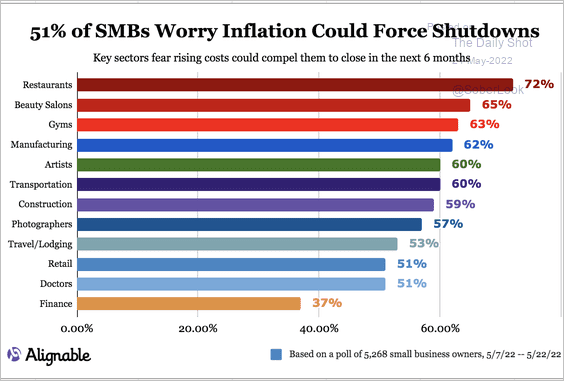 Source: Alignable
Source: Alignable
3. Tech mega-caps’ cash balances:
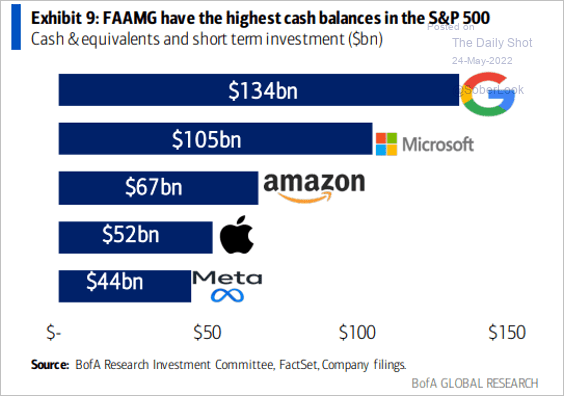 Source: BofA Global Research; @MikeZaccardi
Source: BofA Global Research; @MikeZaccardi
4. Delivery speed of online orders:
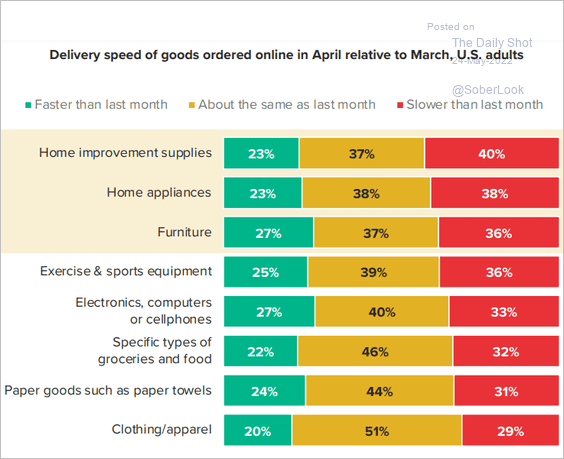 Source: Morning Consult Read full article
Source: Morning Consult Read full article
5. Food delivery online platforms’ market share:
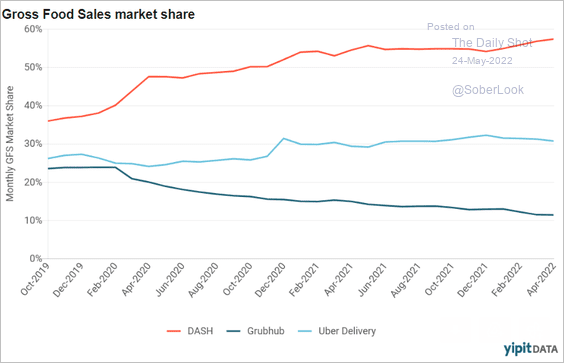 Source: YipitData
Source: YipitData
• Orders per active customer:
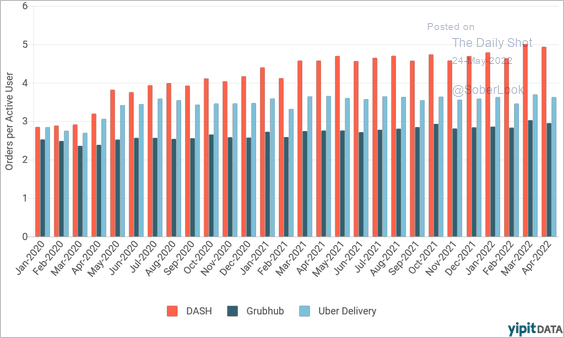 Source: YipitData
Source: YipitData
——————–
6. Asian American & Pacific Islander share of the population:
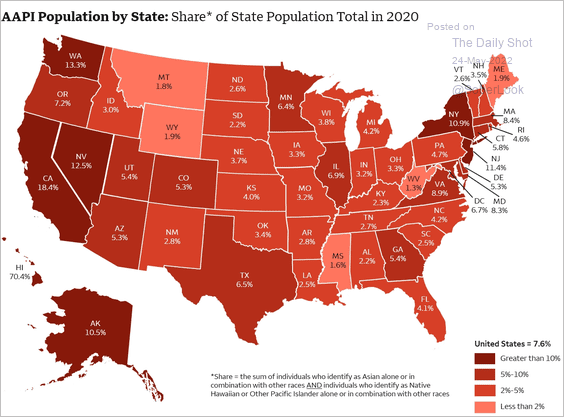 Source: Wells Fargo Securities
Source: Wells Fargo Securities
• Asian American population growth:
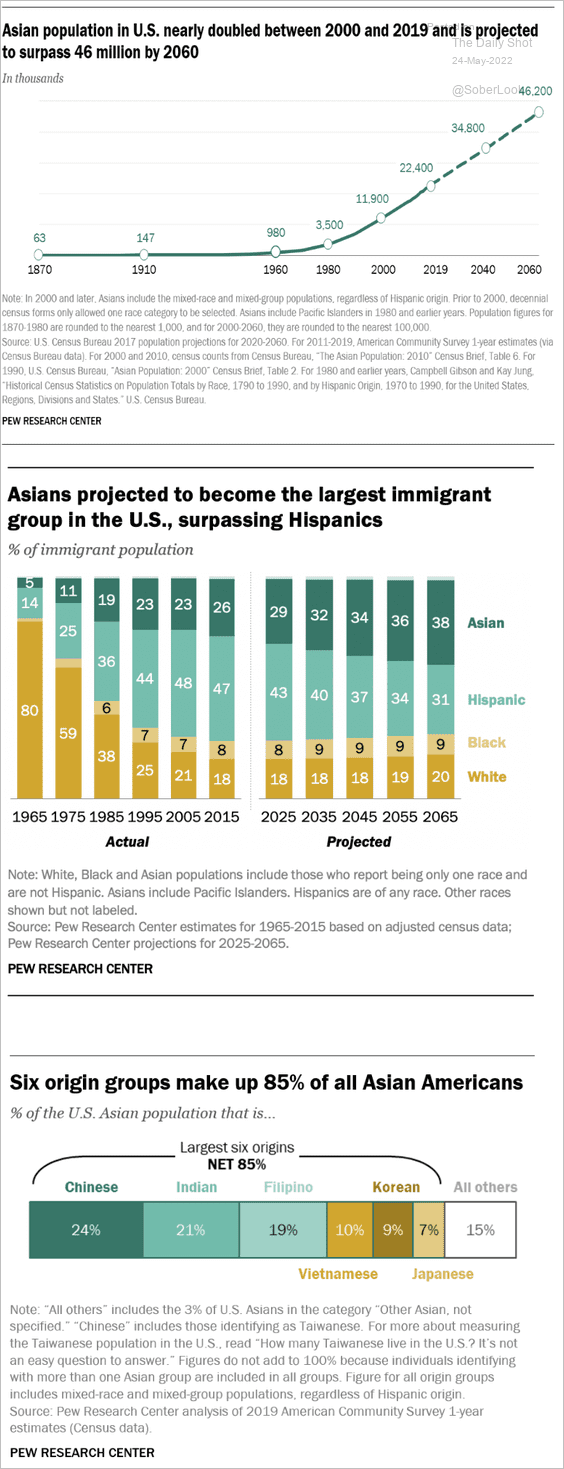 Source: Pew Research Center Read full article
Source: Pew Research Center Read full article
——————–
7. Contested state legislative primaries:
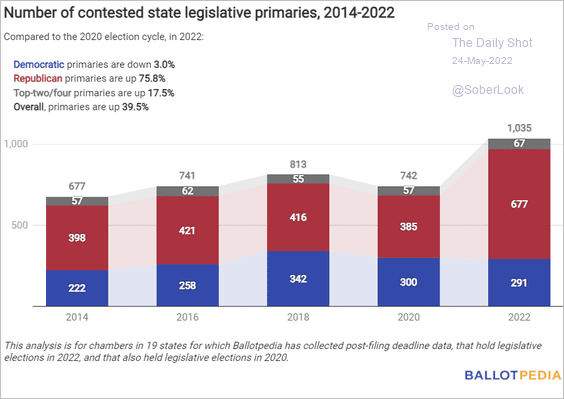 Source: @ballotpedia
Source: @ballotpedia
8. Countries with the most islands:
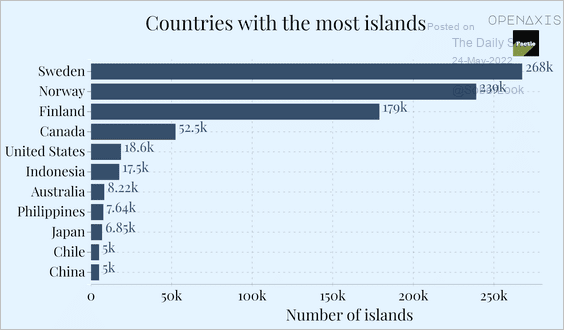 Source: OpenAxis Read full article
Source: OpenAxis Read full article
——————–
Back to Index
